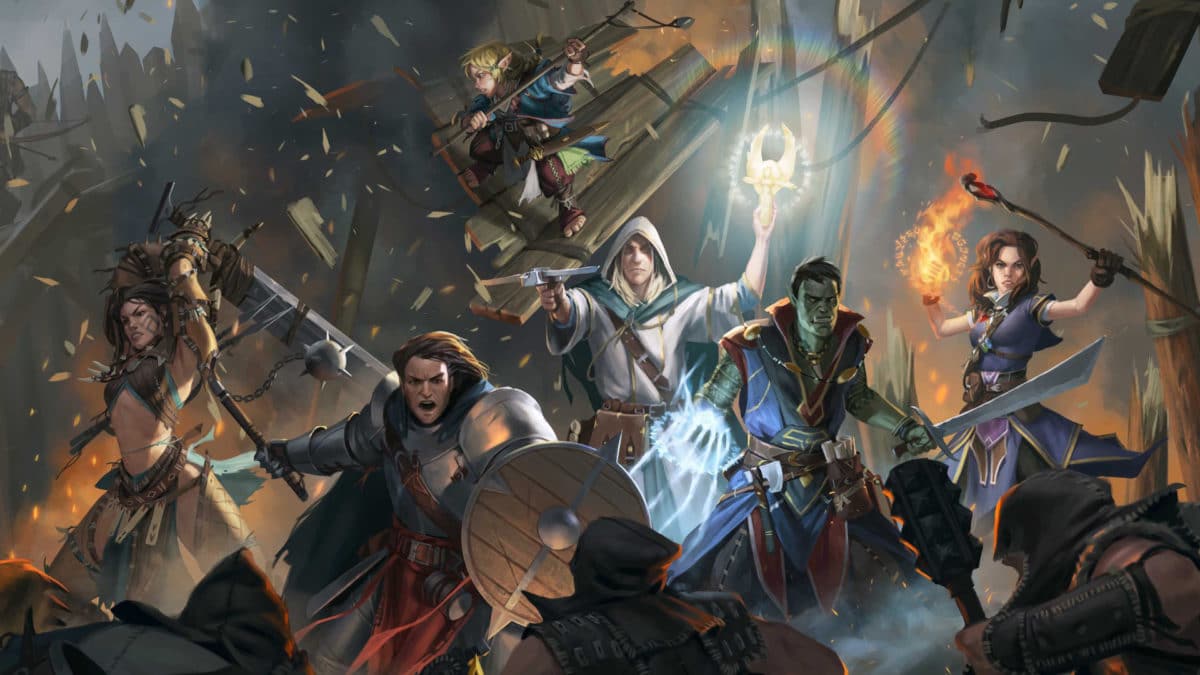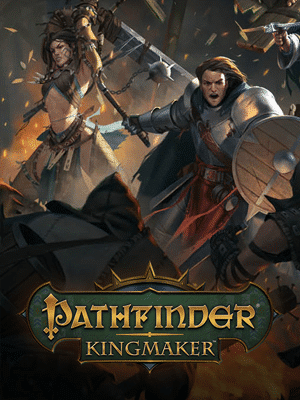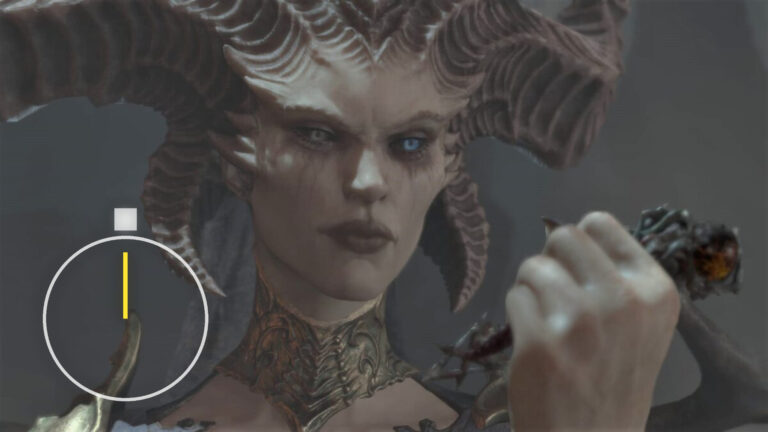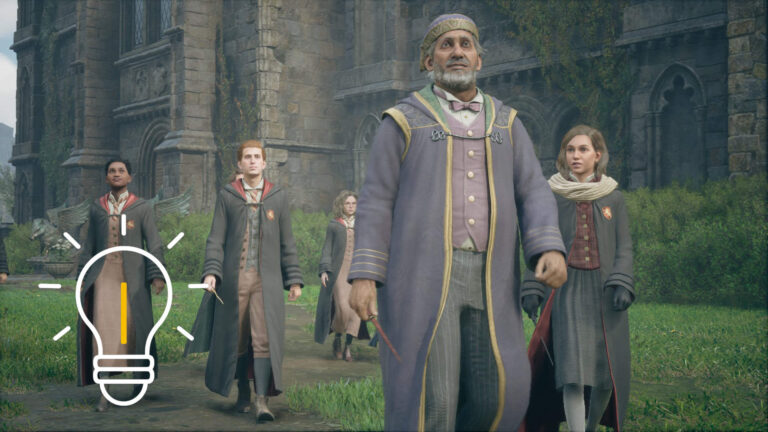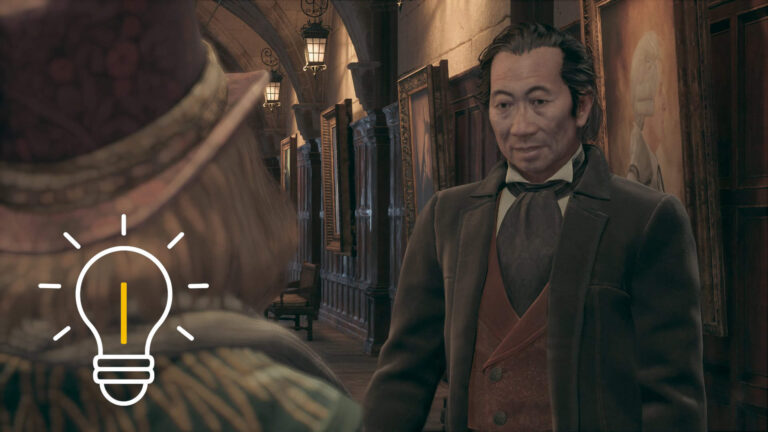Pathfinder: Kingmaker is a very complex role-playing game. We help you with character creation, combat, advisors & much more.
In this guide we tell you
- What kind of game Pathfinder: Kingmaker is and what the system requirements are?
- How to create your character correctly
- Which party features exist and how to use them correctly
- Tips & Tricks you should know about gameplay, travelling & resting
- How to fight properly and what you should do in case of defeat
What is Pathfinder: Kingmaker?
- Pathfinder: Kingmaker is an isometric computer role-playing game (CRPG), comparable to the Baldur’s Gate Saga or Pillars of Eternity. In the game we control a group of up to six heroes through a big adventure.
Isometric role-playing games are characterized by the top view, so we see our group of heroes or our main character from diagonally above. In Pathfinder: Kingmaker we control up to six individuals: the main character and up to five companions.
The game is based on the Pen & Paper rulebook Pathfinder, an outtake of the popular Dungeons & Dragons rulebook (D&D). Version 3.5 was then available as Open Game License and Publisher Paizo used it as a basis for Pathfinder. The simplifications of the following D&D versions were not adopted by Pathfinder. Between 2011 and 2014, Pathfinder even surpassed its role model and became the market leader.
Pathfinder is located in the world Golarion. There are different campaigns that can be played in Pen & Paper. One of these is Kingmaker, which provides the foundation for the computer role-playing game.
What are the PC system requirements for the role-playing game?
- Minimum
CPU: E1400 Dual Core 2,0 GHz or Athlon 2 X2 260u
Graphics: Geforce GT 520 or Radeon HD 7570M
RAM: 4 GB
Storage: 36 GB - Recommended
CPU: Core i7 920 Quad 2,67 GHz or FX-8120
Graphics: Geforce GTX 960M or Radeon HD 5770
RAM: 8 GB
Storage: 36 GB
Where can I buy Pathfinder: Kingmaker?
Will Pathfinder: Kingmaker be released on PS4 and Xbox One?
- Pathfinder: Kingmaker is now available for both PS4 and Xbox One.
The financial success of Pathfinder: Kingmaker for PC was obviously enough to bring the game to consoles. The role-playing game is available for PlayStation 4 and XBox One since August 18, 2020.
How much scope and playtime does Pathfinder: Kingmaker offer?
- Pathfinder: Kingmaker contains seven acts and takes at least 80 hours to complete.
Besides the actual role-playing game Pathfinder: Kingmaker contains a complex management of a kingdom. The latter can be automated, but much of the context and atmosphere will be lost. Read all about kingdom and advisors in Pathfinder: Kingmaker in the linked guide.
If you try to do everything possible and take your time, you can easily spend 40 hours with the first two acts alone.
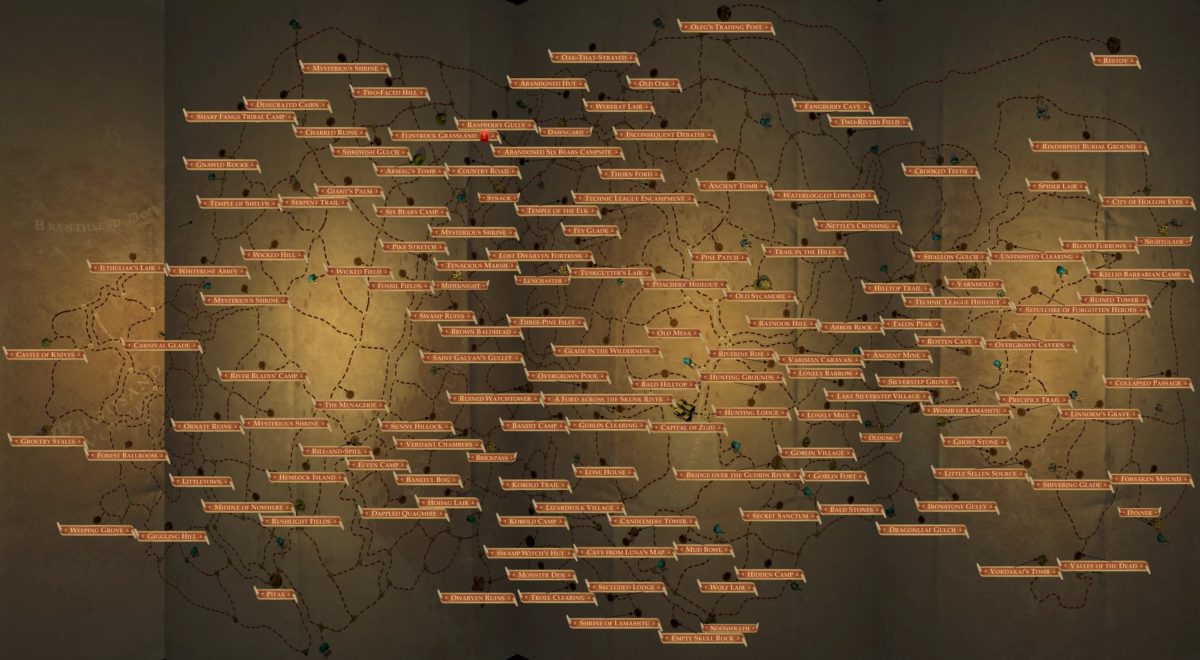
Pathfinder: Kingmaker offers seven acts. In addition, there are seven different endings (including a secret “real” ending for which you get an achievement) and eleven different companions, which greatly enhance replay value. Reports from players who have completed Pathfinder: Kingmaker indicate 200 hours of playtime on challenging difficulty level.
Are there any modifications and additional downloads (for example character portraits)?
- Currently there are no plans for mod support on the developers side. However, there are modifications available for download on Nexus Mods, independently of the Steam games platform, including many new character portraits.
As a developer of Owlcat Games said on Steam, they would like to offer official mod support, but the feature is on relatively low end on their wish list.
However, there is already a modding community that has released a number of modifications. On the well-known mod site Nexus Mods you will not only find a lot of new character portraits, but also modifications for resetting characters (Respecialisation), faster travelling and other cheats.
Are DLCs planned for Pathfinder: Kingmaker?
- In addition to the free mini-DLC “Bloody Mess”, three more DLCs have been released: “The Wildcards”, “Varnhold’s Lot” and “Beneath the Stolen Lands”.
The first download content for Pathfinder: Kingmaker is Bloody Mess. The small and free content update brings blood stains to characters and enemies that depend on how much hit points a character has left. These blood stains will remain until the character is either healed or rests for a full recovery.
The following DLCs are available:
- The Wildcards (Release: 14.12.2018)
Brings the Tiefling race and the Kineticist as a new playable class into play. Additionally there is a new companion with her own story.
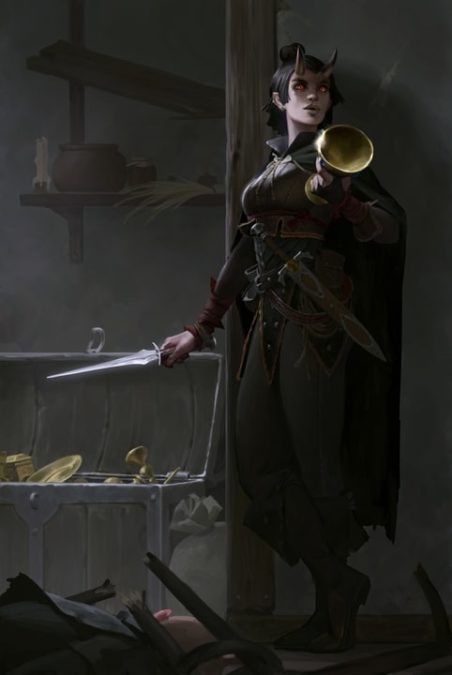
- Varnhold’s Lot (Release: February 2019)
The events of the campaign are portrayed from a different perspective in this approximately 12-hour long new story. The decisions we made during the main storyline have an impact on it. - Beneath the Stolen Lands (Release: April 2019)
Similar to the Endless Paths of Old Nua in Pillars Of Eternity, this DLC for Pathfinder: Kingmaker provides a challenging dungeon. However, unlike Old Nua, it is procedurally generated and endless. The DLC is all about fighting and doesn’t feature a new story.
All three DLCs can be purchased for 24,99 Euro at GOG or Steam as part of a Season Pass.
S4G-Review of Pathfinder: Kingmaker
Pathfinder: Kingmaker is suitable for you if…
- you like to play games like Baldur’s Gate, Pillars of Eternity or Divinity: Original Sin
- you are not afraid of complex game mechanics
- you don’t need everything prepared bite-sized, instead you can extract the available information from tooltips, description texts, the encyclopedia and through your own observations
- you are aware that in this game (as in the Pen & Paper) dices will be rolled for results
- you are aware that in the open game world (the map is fully accessible from the beginning) you can’t defeat everything and everyone immediately, and for some challenges you first have to level up and gain experience
- hard fights, which you may have to try several times, don’t make your blood boil
Pathfinder: Kingmaker is not suitable for you if…
- you have no patience and long journeys will drive you crazy
- you don’t feel like adjusting the level of difficulty to suit your playstyle
- Dice games regularly give you tantrums
- focused familiarization and reading aren’t your thing
- Baldur’s Gate for you is an overrated game from a time long gone
Beginner Guides & Tips for Pathfinder: Kingmaker
Guide to the settings
How do I set the level of difficulty correctly?
The level of difficulty is an important topic for a successful gaming experience. The setting options are complex. For a successful game run you should configure the difficulty level in Pathfinder: Kingmaker correctly, as we describe in detail in the linked article.
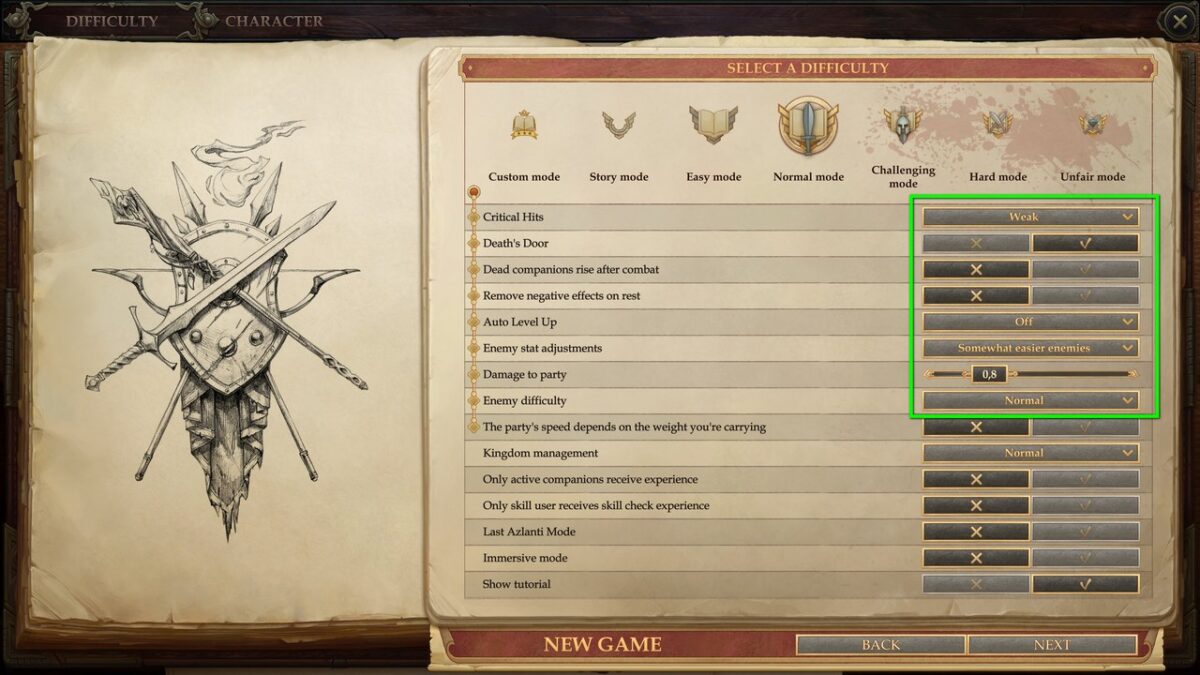
Why is the autopause so important and how do I configure it correctly?
- Under certain circumstances, which can be defined by the player, the game stops automatically and gives us time to react to a new situation.
Pathfinder: Kingmaker is a real-time role-playing game. This means that our party members and possible enemies act in real-time and not turn-based. This can be overwhelming for some players, because with six team members and multiple enemies, events on the field happen way too fast for us to react to them immediately.
Instead, we need time to prepare for a fight or to choose the right abilities and spells. To do this, we can either manually trigger a pause (hoping it’s not too late) and then plan our actions. We can also choose the much more convenient autopause option. In our guide to the difficulty level in Pathfinder: Kingmaker we have explained properly, why the autopause is so important.

- Pro Tip: During combat, you can use the Tactical Time Flow option (Shift + Spacebar) to make combat run in Super Slow Motion.
Tips & Tricks for Character Creation
In this section
- How do I create my character appropriately?
- Strategy Guide for Character Creation
- What kind of hero do you want to be?
- Which races are available and which should I choose?
- Which classes are available in Pathfinder: Kingmaker and which is the best?
- Which prestige classes exist and which prerequisites do they have?
- What alignments do exist and what is their impact?
- Which ability scores exist and how should I allocate them?
- Which feats should I choose?
- Which skills are particularly important?
- How do I properly level up my character?
- Is multiclassing worth it?
- What is the maximum level in Pathfinder: Kingmaker and can I reset my stats (Respec)?
In this guide section you will learn about
- what you should pay attention to when creating characters
- which classes and prestige classes exist
- how to skill your characters properly and whether multiclassing is worth it
How do I create my character appropriately?
- Read the descriptions of classes, attributes, abilities, skills and spells carefully and specialize your character to your preferred way of playing.
The character creation in Pathfinder: Kingmaker is pretty complex. We select our character from 15 different classes and try to develop it with six attributes, eleven skills and countless spells and abilities in the direction we want.
Perhaps the most important tip on this topic is: Read the descriptions of the classes and their variations, as well as their attributes, skills and abilities carefully.
Stick to a clear plan, because a jack-of-all-trades is able to do a little bit of everything, but nothing properly. Over the course of the game, you’ll face a few opponents who will test you to the limit. If you don’t have fully developed and specialized characters on the field, you can quickly look like a fool.
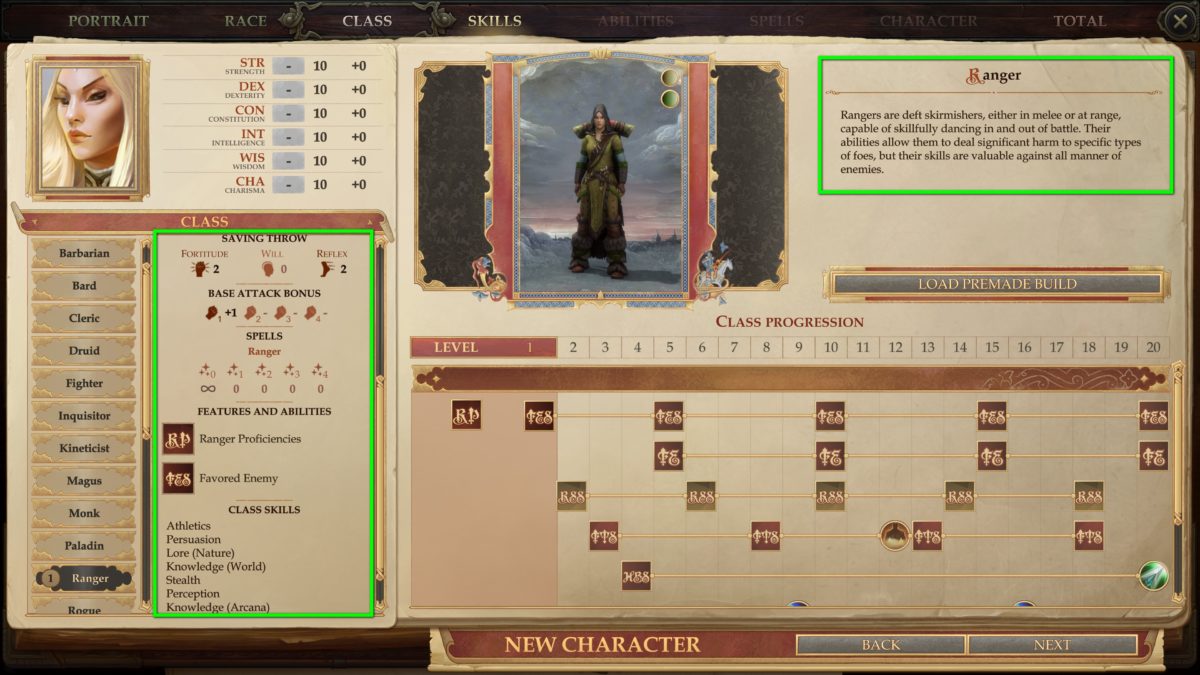
A wizard who can do a bit of Conjuration, a bit of Evocation, a bit of Necromancy and maybe some Illusion may have a spell for most situations. However, the effect of his magic is accordingly weaker than that of a magician who concentrates fully on one magic school and selects only appropriate talents. This doesn’t mean that you shouldn’t learn different magic schools, but especially for the beginning a specialization makes much more sense. Once you’ve gained enough experience with the Pathfinder rules, you’ll be able to broaden your abilities and spells and align different combat styles and magic schools.
Unfortunately, there is no character planner for this complex endeavor, so you’ll have to figure it out by yourself. Take your time and you won’t have to worry later on about mistakes that can have significant consequences (for example, if we’ve skilled a weapon focus for a type of weapon we don’t use anymore).
Strategy Guide for Character Creation
In Pathfinder: Kingmaker you can easily select a main character from the game templates and play with it. The developers of Owlcat Games have created a few well-balanced characters that offer enough opportunities for players who don’t want to worry about character creation.
But if you want to create your own individual hero, you can’t do without proper planning. We’ve put together some questions to help you create your character.
What kind of hero do you want to be?
Would you rather be in close combat at the front? Would you like to fight with a two-handed weapon or would you like to use shield and one-handed weapon instead? Would you like to shoot with a crossbow or bow or would you like to throw bombs?
What about support? Do you want to help your group indirectly or maybe as a healer? Do you like magic and throwing spells around? Once you are clear about your basic orientation, choose a class. We’ll talk more about that in a moment.
Which races are available and which should I choose?
- There are nine races in Pathfinder: Kingmaker: Aasimar, Dwarves, Elves, Gnomes, Half-Elves, Halflings, Half-orcs, Humans, Tieflings (DLC “Wildcards”).
If you are looking to create the perfect character (so-called min-maxing), read the race descriptions carefully and adapt their advantages and disadvantages to your class and playing style.
However, we recommend that you choose a race that feels authentic and right for you, meaning that it takes the role-playing aspect into account. A game as complex as Pathfinder: Kingmaker, which you play for dozens and perhaps hundreds of hours, is much more fun if you are able to identify with your character.
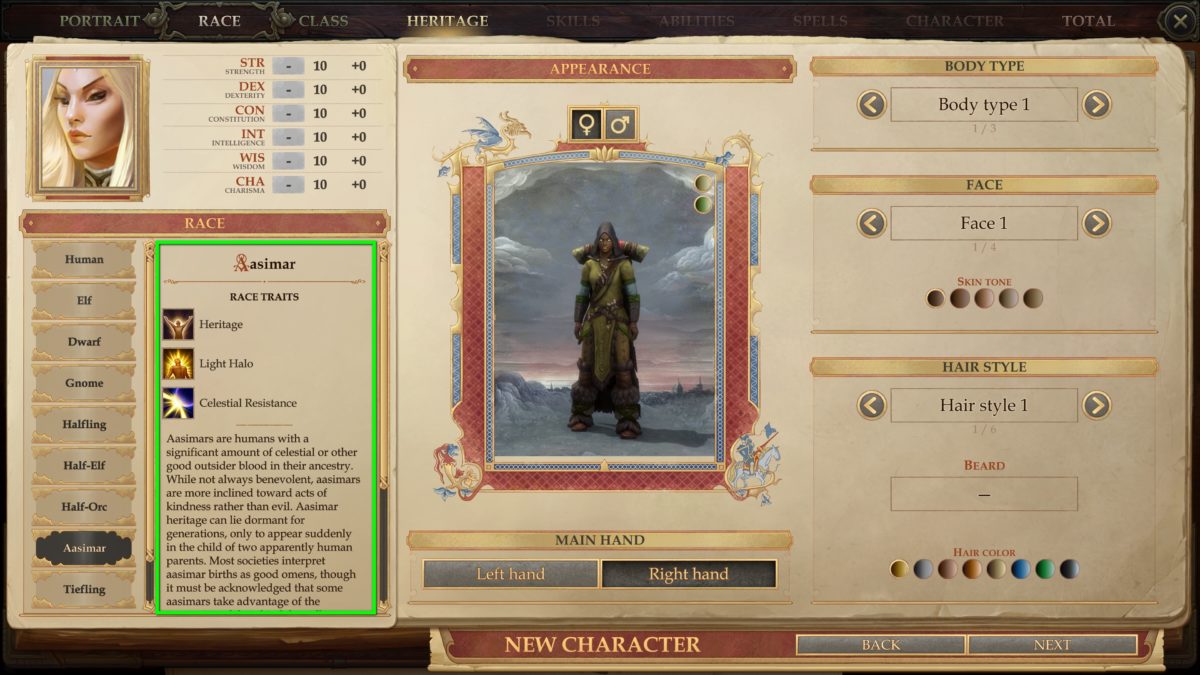
An orcish healer can have more personality than a typical dwarven priest who masters the clerical arts perfectly, but as a stereotype is just boring. Don’t forget: This is a role-playing game and not a breeding bull competition. A story is told and written here and it lives from both successes and failures.
Which classes are available in Pathfinder: Kingmaker and which is the best?
- There are 15 classes in total: Alchemist, Barbarian, Bard, Cleric, Druid, Fighter, Inquisitor, Kineticist (DLC “Wildcards”), Magus, Monk, Paladin, Rogue, Ranger, Sorcerer, Wizard.
Each one of the 15 classes play completely different and has a lot of subtleties (including a number of subclasses with their own specifics) that qualify them for different roles. For example, you can play a fighter and a paladin in the same way (as a tank with sword and board). Nevertheless, the fighter will have the better direct combat prerequisites (for example, through his bonus combat talent or armor proficiency), while the paladin can support the entire group with auras.
It is therefore worth taking a closer look at which class offers which advantages and disadvantages. The encyclopedia in the game offers a lot of information. You can also inform yourself about the classes in the Pathfinder Wiki.
There just is no such thing as a best class. It depends entirely on your personal preferences and your way of playing. All in all, each individual class can be developed into a very powerful tool in your team. All you have to do is patiently work it out in detail.
Which prestige classes exist and which prerequisites do they have?
- There are six prestige classes in Pathfinder: Kingmaker: Arcane Trickster, Duelist, Dragon Disciple, Eldritch Knight, Mystic Theurge, Stalwart Defender.
Prestige classes give characters additional extraordinary abilities. For example, an Arcane Trickster combines the abilities of a Rogue with the powers of a Wizard in a special way. Additional spells and improved Sneak attacks are some of the advantages of this prestige class. However, to choose a prestige class, a character must meet certain prerequisites, such as a certain alignment and certain ranks in different skills.
Below we have compiled an overview of the prerequisites for prestige classes. Unfortunately, the information’s not complete yet, but we will update them as soon as possible.
Overview: Prestige Classes
| Prestige Class | Basic Class (or Combination) | Prerequisites | Notable Features |
|---|---|---|---|
| Arcane Trickster | Kineticist Magus Rogue Wizard | Alignment: non-lawful Trickery: 4 Mobility: 4 Sneak Attack: 2 Ability to cast arcane spells 2nd level spells Knowledge (Arcana): 4 | Improved Sneak Attacks Can use Trickery at a range of 30 feet Invisibility Surprise Spells |
| Dragon Disciple | Kineticist Magus Sorcerer Wizard | Ability to spontaneously cast arcane spells 1st level spells (except for the special class variants of the Sorcerer) Knowledge (Arcana): 5 No Bloodline except the Draconic Bloodlines (only Sorcerer) | Draconic Bloodline Dragon Bite Breath Weapon Dragon Form |
| Eldritch Knight | Fighter Barbarian Kineticist Magus Paladin Sorcerer Wizard | Ability to cast arcane spells 3rd level spells Martial Weapons Proficiency | Bonus Combat Feat Extra Spells per Day |
| Mystic Theurge | Cleric Kineticist Sorcerer Wizard | Knowledge (Arcana): 3 Lore (Religion): 3 Ability to cast arcane spells 2nd level spells Ability to cast divine spells 2nd level spells | Extra arcane and divine spells per level Combined Spells |
| Stalwart Defender | Barbarian Fighter Paladin Rogue | Base Attack Bonus: 7 Dodge, Toughness | AC Bonus (Dodge) Defensive Stance Defensive Powers Uncanny Dodge Damage Reduction |
| Duelist | Bard Rogue | Base Attack Bonus: 6 Mobility: Dodge, Weapon Finesse, Combat Mobility | Canny Defense Precise Strike Improved Reaction Combat Reflexes Crippling Critical |
What alignments do exist and what is their impact?
- There are nine different alignments in Pathfinder: Kingmaker: Lawful Good, Neutral Good, Chaotic Good, Lawful Neutral, Neutral, Chaotic Neutral, Lawful Evil, Neutral Evil, Chaotic Evil.
Pathfinder: Kingmaker is a real roleplaying game. Playing a role involves making ethical and moral decisions. These depend, among other things, on the basic alignment of a person or creature.
As in D&D, the Pathfinder rulebook defines the ethical attitude by a combination of two elements: The first element indicates whether a character is lawful, neutral or chaotic. The second element determines whether a character is good, neutral or evil.
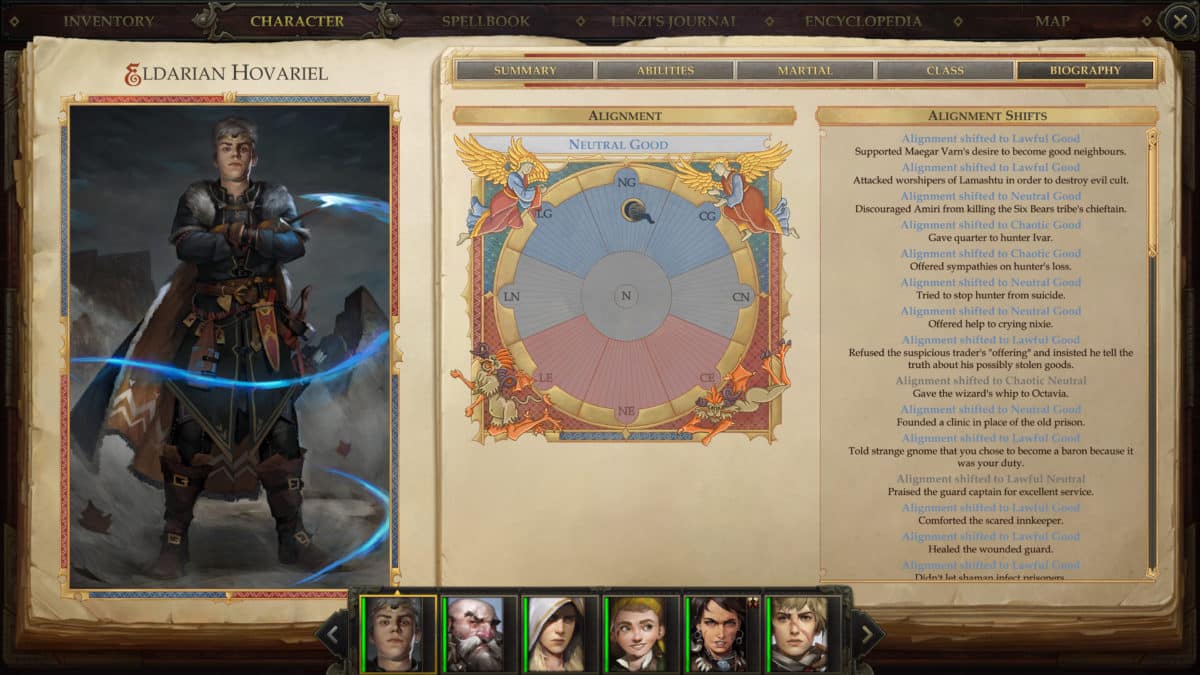
By the way: The alignment of the main character also affects the people living in our barony. It also influences what kind of people our country attracts. If we are evil, we should not be surprised about criminal and malicious subjects.
Depending on our alignment, even our own capital can change its appearance.
List of all nine alignments
Overview: Alignments
- Lawful Good
Such a character has the desire to fight evil and injustice. He always tells the truth, sticks to his word and cannot bear it if the guilty go unpunished. - Neutral Good
A character with this mindset always tries to help others and do good, but positions himself neither for nor against the legislature. - Chaotic Good
These characters are primarily guided by their conscience. They are friendly and have faith in what is good in the world, but follow their own moral compass, which can differ from the prevailing values of their society. - Lawful Neutral
Law, tradition, honor, order and structure are essential for this alignment. However, the love of law and order does not turn into blind Fanatism. - True Neutral
Such characters are the Switzerland of role-playing games. They try to keep themselves everywhere in the middle, to avoid clear decisions and don’t want to be pinned down to a clear opinion. After all, they consider good people to be more favourable than bad people, but would not strongly support a good case. They won’t let themselves be forced into anything and try to be free of preconceptions. - Chaotic Neutral
These individualists are mood-driven characters who put their own freedom above all else. They don’t like laws and traditions, but they don’t pursue fanatical or anarchic agendas. Chaotic neutral beings consider themselves completely free. - Lawful Evil
A character with this alignment takes everything he wants, regardless of casualties. He is devoted to rules and structures, while abstract things like freedom are of no interest to him. He does not feel compassion or shows any mercy. Instead, he strives for advancement within hierarchical structures. This alignment stands for organized evil, which is performed methodically and systematically. - Neutral Evil
Such characters pursue purely evil intentions and see evil deeds as an ultimate objective. They may not always be looking for trouble, but they do everything they can in order to gain a personal advantage, regardless of losses. Neutral evil characters kill for profit or because they feel like doing so. - Chaotic Evil
Characters with such an attitude are pure scum. Greed and hatred inspire a destructive rage that keeps them going. They are ruthless, brutal and disorganized. Even within vicious groups they are dominated by chaos and easily entangle themselves in bloody conflicts over control.
Which ability scores exist and how should I allocate them?
- Strength, Dexterity, Constitution, Wisdom, Intelligence and Charisma are the six ability scores. Allocate them to the most important ability scores for your chosen class (highlighted with a green marker). Wisdom and Constitution should not fall below ten points.
Each class has two focus abilities. These are highlighted with a green marker. These are your most important stats and you should bring them up to at least 18 points. However, you will notice that the higher the number of the respective ability score, the higher the cost of points needed.
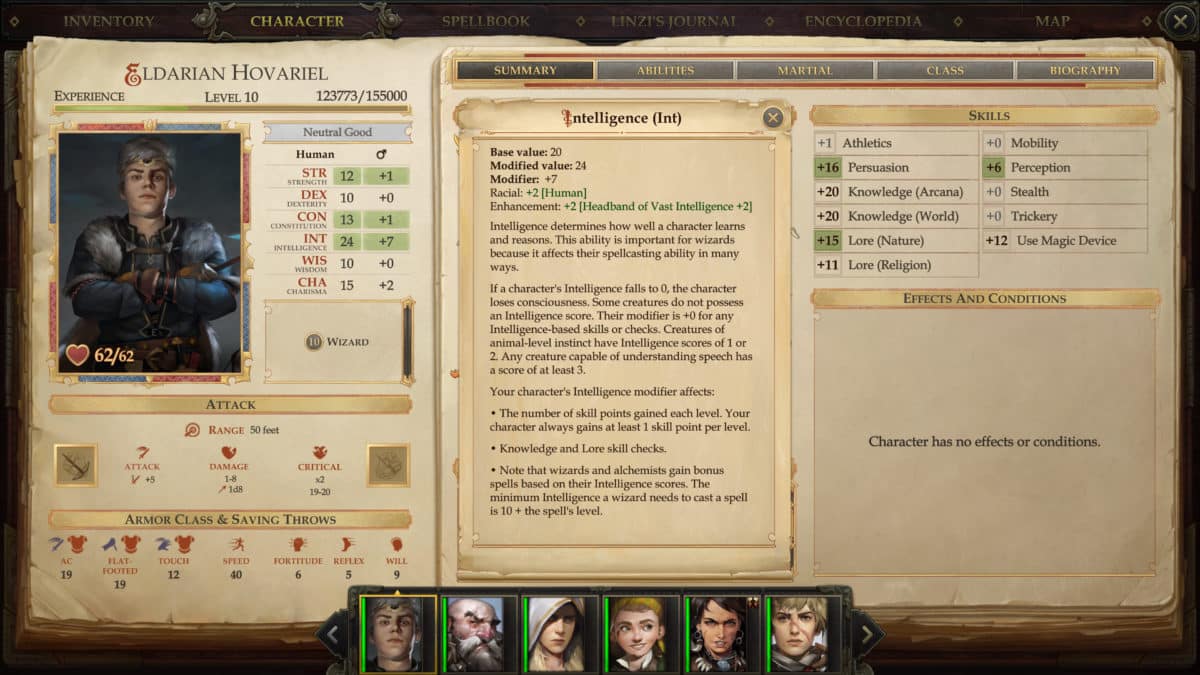
So, consider carefully whether increasing the ability score by one point justifies the investment of a full four points. If you have reached a certain value, it makes more sense to increase other abilities (especially wisdom and constitution) to at least ten points. The lower an ability score is, the more likely it is that a dice roll that affects that ability will fail completely (this also includes saving throws, for example, will saves are determined by the wisdom attribute). However, the higher an ability score is, the more likely attack, damage and saving throws are to succeed.
You can also plan with magical items that give you bonuses on certain ability scores. For example, a Belt of Giant Strength will give you bonuses on Strength. Accordingly, you may not increase strength as much in character creation, but you will need to have this character wear a matching belt permanently and be unable to wear other, perhaps more helpful belts, or may only be able to do so by significantly reducing his/her Strength.
- Pro Tip: Charisma is a particularly important ability for the main character. It not only determines how NPCs react to us and whether we can influence or convince them. Charisma also affects our position as rulers of a kingdom (diplomacy). Since our main hero engages in most conversations in the game a low charisma would be somewhat of a hindrance. If you don’t want to authentically role-play a stupid Orc, you should definitely put a few points in charisma. Charisma also decides if you can use magic items. One or two wands (that have a certain number of spells attached to them) in your belt can make the difference in a close battle.
Which feats should I choose?
- Focus on offensive feats at the beginning of the game and then turn to more defensive ones as the game progresses.
Especially at the beginning of the game, you’ll notice that the attacks of your party members often miss the target. With offensive feats (such as weapon or spell focus) you can increase your chance of successful hitting the target.
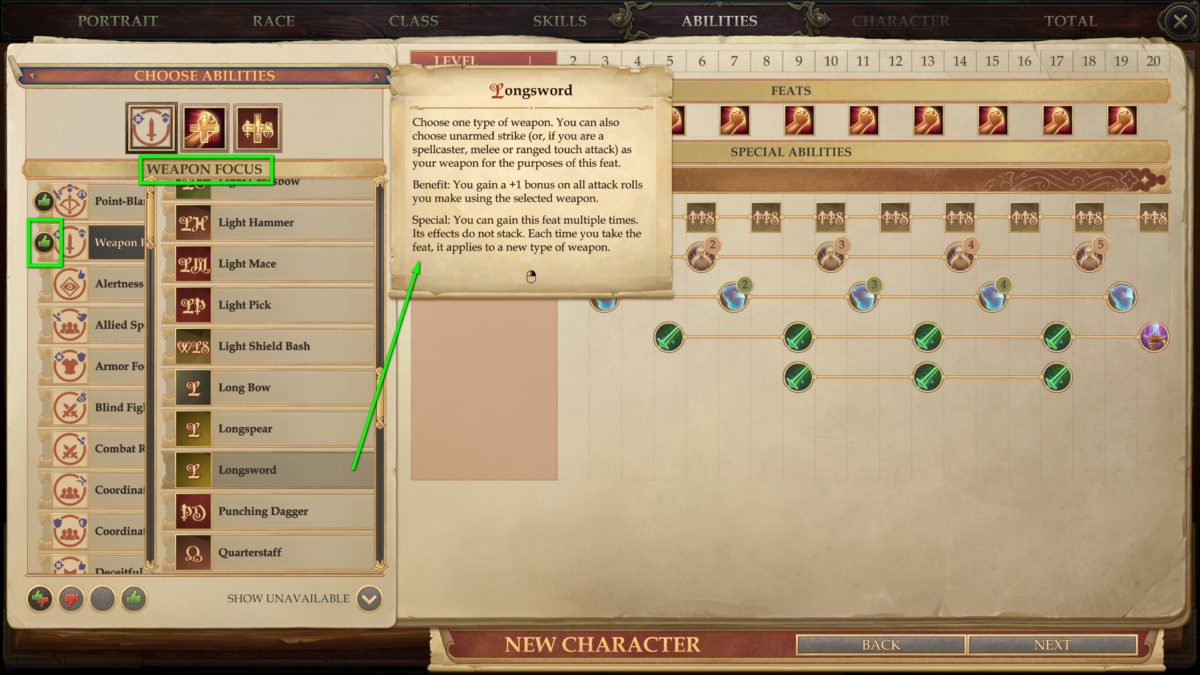
As you progress through the game and face tougher opponents, you’ll want to turn to more defensive feats (such as Toughness or Dodge) – provided, of course, that they match your play style.
Which skills are particularly important?
- In order to lower the level of difficulty in some way, Lore (Nature) is very important as it increases the chance to avoid random encounters. Otherwise, the skills that are appropriate for the respective class should be mastered.
There are eleven different skills that complete our character: Athletics, Persuasion, Knowledge / Lore (in the variants Arcana, World, Nature, Religion), Mobility, Perception, Stealth, Tricks and Use Magic Device. Pay attention to the descriptions of these skills and limit yourself to those that fit your class (green marker!).
For example, a character with high wisdom is predestined for perception. A magician will prefer Knowledge (Arcana), and bards or rogues (as well as other highly dexterous characters) are good with Stealth and Tricks. In addition to specializing in the skills appropriate to the class, almost all characters can use magical items. It may be advantageous if the magician can use this skill to resurrect the newly passed away cleric by using a scroll.
How do I properly level up my character?
- Specialize your hero in specific weapons, armor and spells. If no matching feats are available, focus on improving your saving throws.
Once you’ve chosen your class and style of play (for example, damage dealer in melee combat), you’ll at best have an idea of what weapons, armor or spells you’d like to work with. When you’re leveling up, you’ll be able to choose the feat that suits you best. Two-handed weapon feats aren’t very helpful when you’re shooting with a bow.
Pathfinder: Kingmaker gives you clues about which feats are best for your character. Even though these hints are relatively rough and do not perfectly match your playing style, you can use them as a guideline. Especially the feats marked in red should usually be completely ignored.

If there are no feats that match your weapon, armor or spell type, or if the recommended feats are not what you want, you should learn everything that affects your dice results. This includes initiative (determines in which order and how fast someone can act at the beginning of a battle) but also saving throws (e.g. will or toughness).
You should also increase the ability scores that are important for your class. Only deviate from this if you notice that some other abilities are in urgent need of improvement (for example, because you have allocated less than ten points to that ability when you created your character and the corresponding saving throws now fail regularly).
Be sure to specialize your skills. A wizard who improves Athletics, Tricks or Stealth is wasting points. Instead, the knowledge and lore skills are of particular interest to him, especially Arcana. A rogue, on the other hand, will want to maximize stealth and tricks so he can sneak around enemy camps and open difficult locks.
Is multiclassing worth it?
- We recommend to avoid multiclassing in your first play session (except if you’re looking for prestige classes), because it takes a very good understanding of the game mechanics to build a powerful character with more than one class.
What is the maximum level in Pathfinder: Kingmaker and can I reset my stats (Respec)?
- You can reach the maximum level of 20 with your character. Resetting all feats and stats is not yet (officially) possible.
If you are not satisfied with your choice of feats, skills and ability scores for your main character and/or companion, you have a problem: There is no respec option.
That’s why we’d like to point out once again: Don’t rush your character creation and leveling. Consider in advance what you want to achieve with each character and read the descriptions and help notes in the encyclopedia carefully. In the “worst” case you’ll have to restart the game – but you’ll also be a whole lot wiser.
If you are not happy with this, you can try to reset the characters via modification. For this purpose, there are suitable solutions on the mod page NexusMods, for example the modification Respecialization.
Guides to companions & group features
As is usual in many role-playing games, we travel with (up to five) companions through the Stolen Lands in Pathfinder: Kingmaker. They all have their own personality and beliefs as well as individual quests. With some of them even romances are possible.
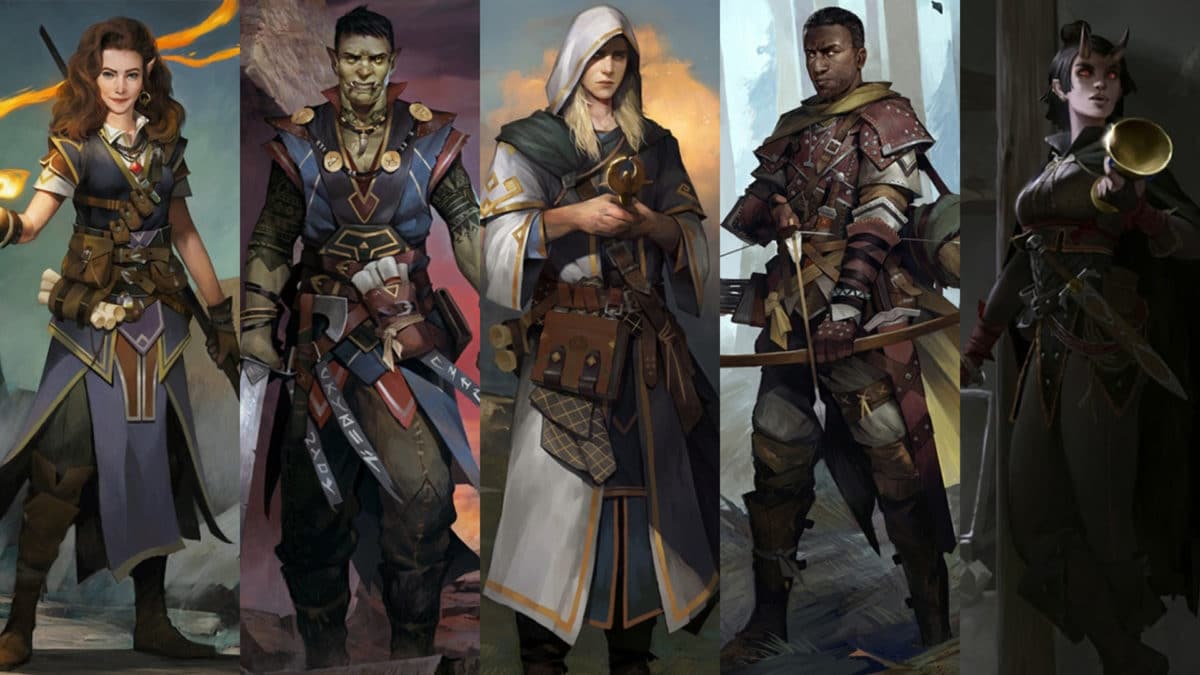
Which companions exist and where can I find them?
- For our adventure we can choose from twelve companions: Amiri, Ekundayo, Harrim, Jaethal, Jubilost, Kaessi (DLC „Wildcards“), Linzi, Nok Nok, Octavia, Regongar, Tristian and Valerie.
We find all companions at different locations in the game world, but usually during the first third of the game. We have put together a guide to companions in Pathfinder: Kingmaker with lots of useful information.
How should I ideally form my group?
- A good party setup is the following: tank, melee damage dealer, wizard, bard, healing cleric and melee cleric.
With this party composition you can bind even large enemy groups with your melee fighters. One Cleric heals the party, the other fights directly and supports the party with healing spells if necessary. The bard is responsible for support (including performances), the wizard deals a lot of damage. The tank is used to give the group enough time and the melee damage dealer flanks enemies and shortens their lives as fast as possible.
In our adventure we play the suggested constellation as follows: Valerie (Tank), Amiri (Melee Damage Dealer), Main Character (Wizard), Linzi (Bard), Tristian (Healing Cleric), Harrim (Melee Cleric). Even beginners can play successfully with this group, as there is enormous healing and support power available.
Group Management
Every time we leave Oleg’s Trading Post or our capital through the map, we have to reorganize our group. Depending on which quest we’re doing, we’ll have to change our usual party and temporarily replace characters.
For example, at some point we’ll be looking for the killer of the undead Jaethal. It makes sense to have her with us on such a quest. Apart from that, we recommend that you always lead the same party into battle so that you can get used to the teamwork and practice effective tactics.
How can I replace companions while travelling?
- You can swap companions on the world map via the “Manage Group” menu.
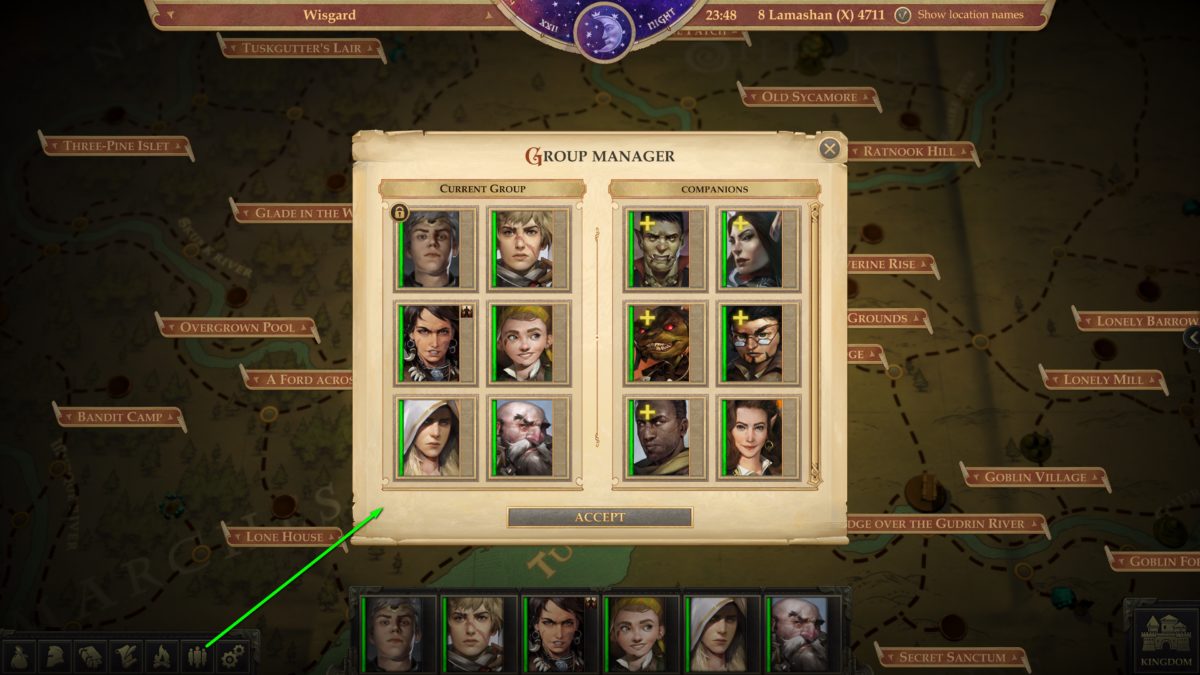
If you are traveling, you can also reconfigure your party if necessary. To do this, go to “Manage Group” in the lower left menu. However, it will take several days to send a companion away and request a new one. The days will be subtracted immediately so we don’t have to wait.
How and why should I adjust the group formation?
- Formations should be set in the lower left menu each time you change the party setup. This will provide safety in case of ambushes.
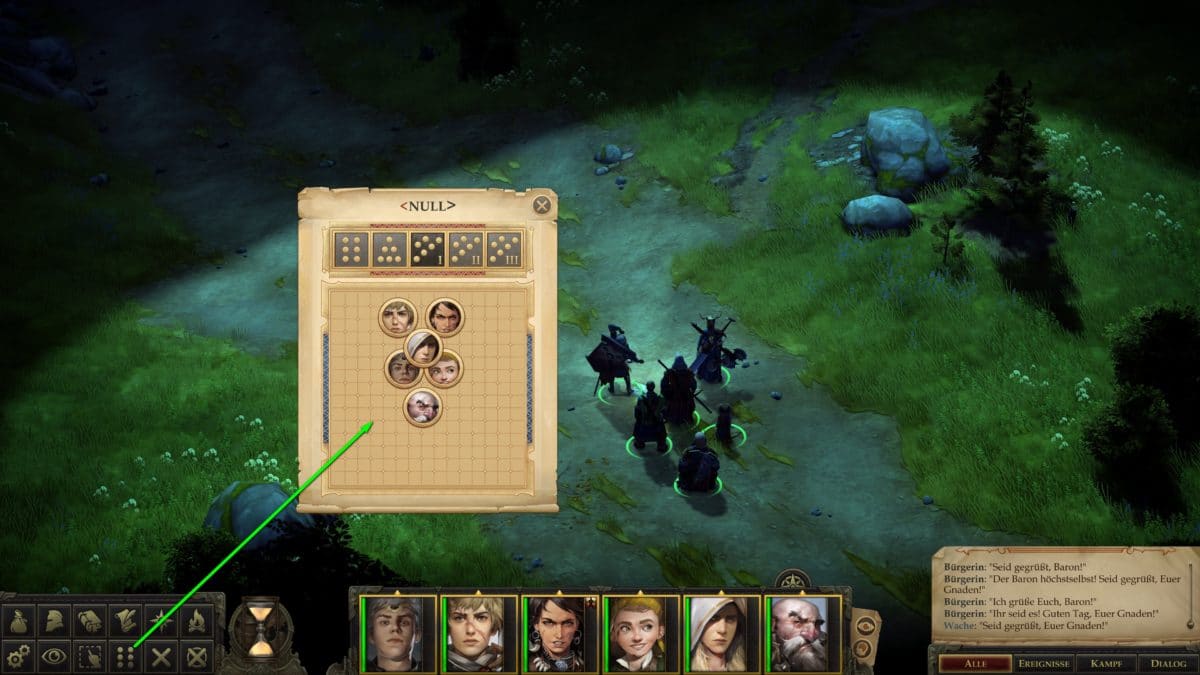
It is absolutely important that you configure the “Formation” option in the lower left menu. There you can define who operates on which position.
It’s a good idea to have at least one melee fighter at the front and one at the back so that you’re prepared for sudden threats from all sides. It may turn out negative if healers and wizards are the taillights of the group and are ambushed in a conflict. Instead, “soft” targets should run in the middle of your party.
Check and adjust the formation each time you change the party.
Gameplay Tips
In this guide section you will learn about
- What basic, general tips you should be aware of
- What the armor class is and how it is calculated
- How items work in Pathfinder: Kingmaker
Saving
- Most important tip: save regularly and frequently.
Games like Pathfinder: Kingmaker contain a lot of surprises and due to the dice results sometimes also severe failures. Therefore create many savegames. - On each new map, create a regular savegame (“Save Game”, not just Quicksave). If you need to restart a map or at a specific point in the game, you will always have a clean starting point.
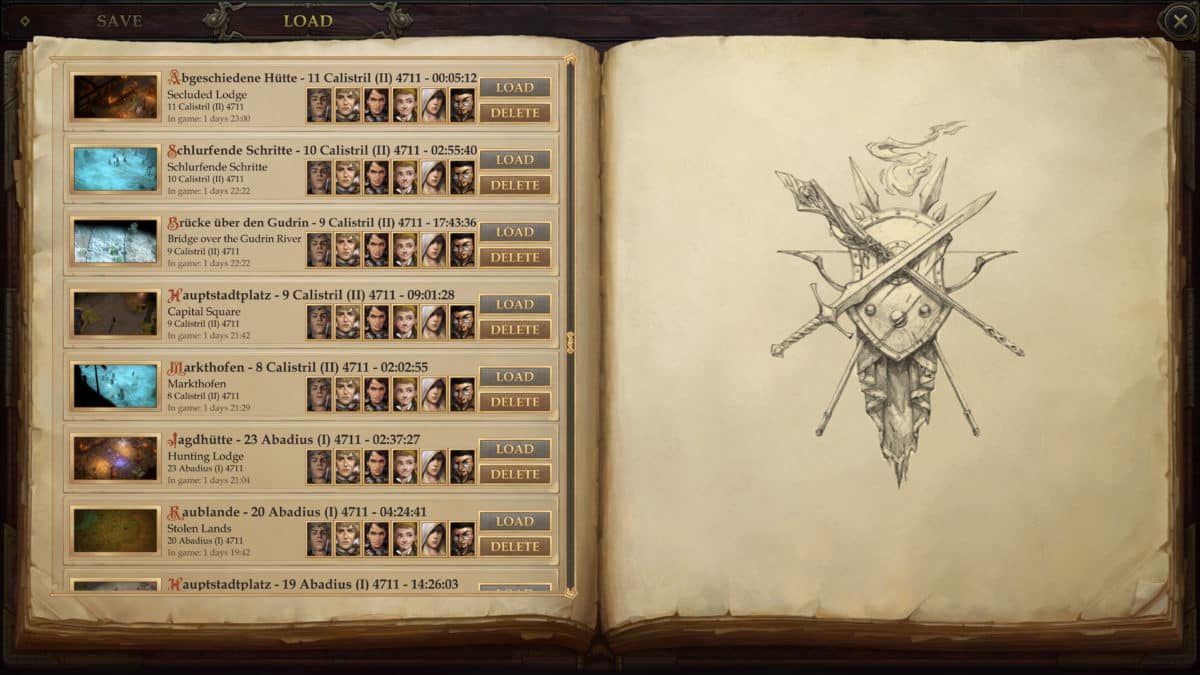
Characters, Party & Inventory
- A double-click on a character lets the camera automatically follow that character. In case of a battle, this will be deactivated automatically.
- Your group can only handle a certain amount of weight. If you are overloaded, you can throw items to the ground (right-click on the item and select “Drop”). If you come back later, the items will still be there. Note: This does not apply to maps of random encounters.
- You can increase the carrying weight of the party by using so-called “Bags of Holding”. We have found the following bags so far:
- on the map Oleg’s Trading Post at Oleg (4,000 Gold, +100 lbs)
- on the map “Lone House” near Bartholomew Delgado (2,500 Gold, +100 lbs)
- on the market place of the capital at Merchant Hassuf (25,000 Gold, +200 lbs)
Merchants and private stash
- Items can be quickly transferred to your stash or to the trading window with CTRL + left-click.
- The “Offer” button at merchants automatically transports all generic sell items (i.e. everything that serves no real purpose) to the trade window.
- If you want to compare an item at a merchant with already equipped items, click on the portrait of the companion carrying the item.
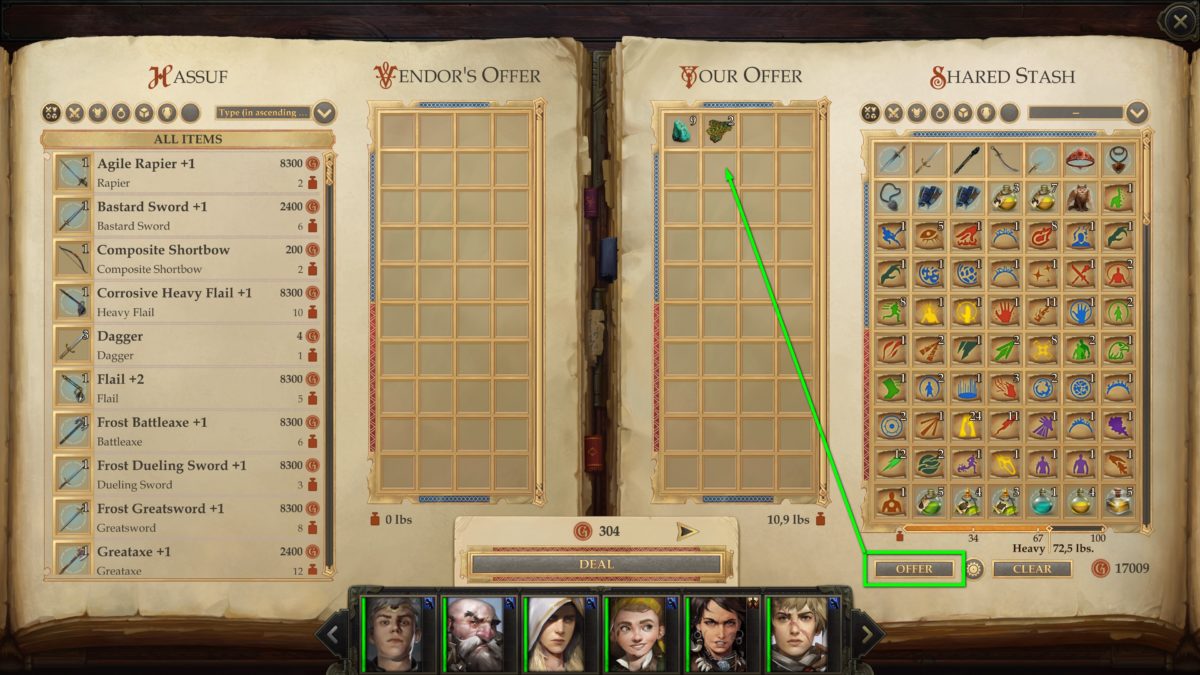
- Before you buy an expensive item of which you are not sure whether it really fulfills the desired purpose, create a savegame.
- You don’t have to run to your stash in the throne room each time to put something in or take something out. It’s sufficient to go to the edge of the map and leave the throne room. Before the new map loads, the stash will be presented to you and you can put in or take out items.
- Wizards can learn spells. Right-click on a scroll in your inventory and transfer the spell to the spellbook. This will consume the scroll. Of course, if you want to use the spell then, you must prepare it in a spell slot first.
- Explore all areas completely. Make sure that one of your characters has a really high perception stat. Besides plants that can be used for cooking, there are always treasure chests or other loot you can find in the wild.
- With the TAB key you can highlight all objects on the screen that can be interacted with.
How to pass skill checks
- Make a Quicksave before trying a difficult skill check (open locks, defuse traps, climb over a ravine, etc.).
- These checks are usually performed by the character with the highest skill rating. The following spells can be used to increase your character’s skill level:
- Inspire Competence (Bard)
- Good Hope (Bard)
- Blessing of the Faithful (Cleric)
- Skills are always based on attributes. A mouseover on the skills (e.g. athletics) shows you which attribute is relevant (in case of athletics it is strength). Depending on which skill you need, you may want to increase the associated attribute through the following spells (Wizard, Bard, Cleric):
- Bull’s Strength (Strength) — influences Athletics
- Cat’s Grace (Dexterity) — influences Mobility, Stealth, Trickery
- Fox’s Cunning (Intelligence) — Influences Knowledge (Arcanum, World)
- Owl’s Wisdom (Wisdom) — influences Perception, Lore (Nature, Religion)
- Eagle’s Splendor (Charisma) — Influences Persuasion, Use Magic Device
- Encumbrance causes a penalty on skill ratings (mouseover on skill indicates this). The spell Bull’s Strength can help here. Optionally, you can take off equipment that doesn’t give you bonuses on skill rolls. Don’t forget to put your equipment on again after you suceeded.
Opening locks and disarming traps
- You only have one attempt to open a lock per character and level. So make a Quicksave (key F5) beforehand.
- Depending on who is responsible for these jobs, it is almost always worth letting a bard (Linzi, for example) use “Inspire Competence” before a lock is opened or a trap disarmed. This increases skill throws for Trickery and success is more likely.
- If you fail and reload the savegame, follow the tips above on passing skill checks.
What is Armor Class and how is it calculated?
- A character’s Armor Class (RK) determines the value that an attacker must reach with his Attack Roll to land a hit that causes damage.
The calculation formula is as follows: 10 + Armor bonus + Shield bonus + Dexterity modifier + other modifiers.
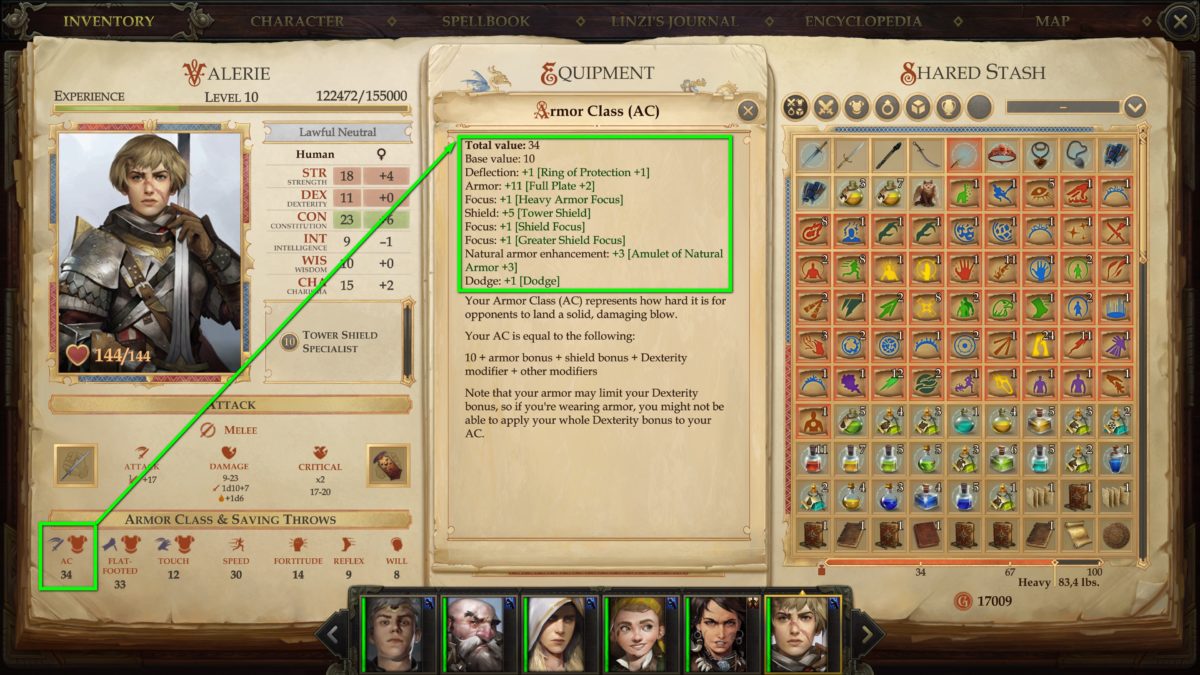
In addition to the natural armor class of a character (the base value is always 10), the armor class is influenced by the Dexterity modifier as well as items (e.g. armor, gloves, amulet, shield). Certain bonuses on the armor class are only calculated once and only with the highest bonus. For example, we can wear a Ring of Protection that gives us +2 AC in form of a Deflection Bonus. Another Ring of Protection with +1 AC would not raise our armor class any more, instead only the +2 bonus is calculated.
In order to determine whether an item is improving the armor class, it helps to simply put it on and check if the armor class changes. A mouseover on the AC value also tells us which armor bonuses affect us and where they come from.
Items & Uniques
As in any good role-playing game, there are lots of items that we get as rewards, purchase, loot from defeated enemies or collect from treasure chests. Many of these items are magical and improve the stats of our characters. Some of them improve the attack roll (for example, weapons with +1 or +2 bonus), add certain damage types (for example, fire or acid) or have other special features (for example, Keen).
In addition, some weapons and armor are made of special materials that have their own special features. Mithral armor reduces weight, has a higher Dexterity bonus and causes fewer spell failures. A cold iron weapon stops the natural regeneration of enemies such as linnorms. Trolls, on the other hand, must be killed with fire or acid, which makes weapons with appropriate enchantment very useful.
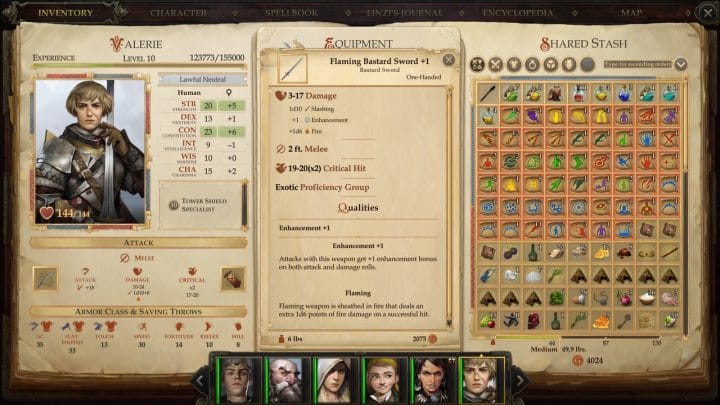
So, it makes sense to have a large selection of items and weapons in your inventory or in the four weapon sets of each character in order to be prepared for all situations. We have listed the best items for you in our comprehensive item guide to Pathfinder: Kingmaker.
Which items or spells should I always carry with me?
- Healing potions, scrolls, wands, a torch, area spells, bombs and/or area damage potions, weapons with fire or acid enchantment, weapons made of cold iron, ingredients for cooking, at least six camping supplies and rations.
Healing potions are of course standard for adventurers. Scrolls don’t weigh much, but they are very helpful in different situations. For example, ”Restoration, Lesser” can remove attribute damage – you won’t have to rest as often to let the Cleric recharge his spells. Magic wands (such as Wand of Magic Missile or Healing Wands) can be used in case your hero runs out of spells in battle.
Area spells or equivalent bombs or potions are helpful against swarms and larger groups of enemies. Weapons with fire or acid enchantment help to finish trolls off and weapons made of cold iron stop the regeneration of monsters. You should also always bring enough ingredients for cooking (merchants have plenty of them) so that you can get helpful buffs through suitable recipes when resting. The rations are important for longer periods of visiting caves or dungeons, where you can’t hunt or cook.
What unique items can be found in Pathfinder: Kingmaker?
Items that have a name (e.g. Vest of Hundred Pockets) are unique items. They usually have special abilities or improvements. For example, the wearer of the Vest of Hundred Pockets gets a +5 bonus on Trickery.
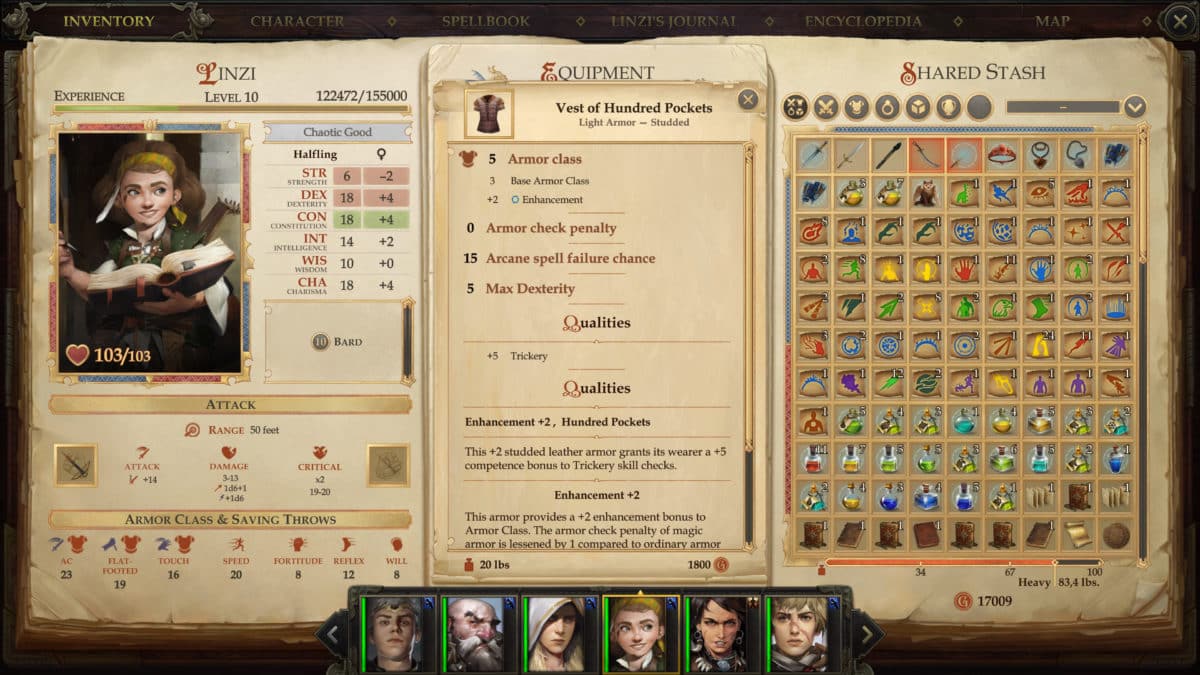
We have many unique and especially good magic items listed for you in our article about items in Pathfinder: Kingmaker. In addition, there are relics and artifacts.
Relics, Artifacts and Fragments
As you explore the world, you’ll find fragments of so-called relics. These are divided into two different groups: story items and artifacts. The former contain an extensive story, which the storyteller (located in the throne room, front left at a pillar) tells you completely as soon as you have brought him all the fragments. Your reward is experience and gold.
The artifact fragments are instead assembled into an item that can be worn by a character. A comprehensive guide to items and relics in Pathfinder: Kingmaker has been compiled for you in a separate article.
Tips to world map, level maps & travelling
Moving the world map
If you are in travel mode, i.e. on the world map, there is a button on the right that allows you to expand a smaller overview of the map. With the help of this overview map you can move the map much faster and jump directly to the desired location than having to scroll with the control keys.
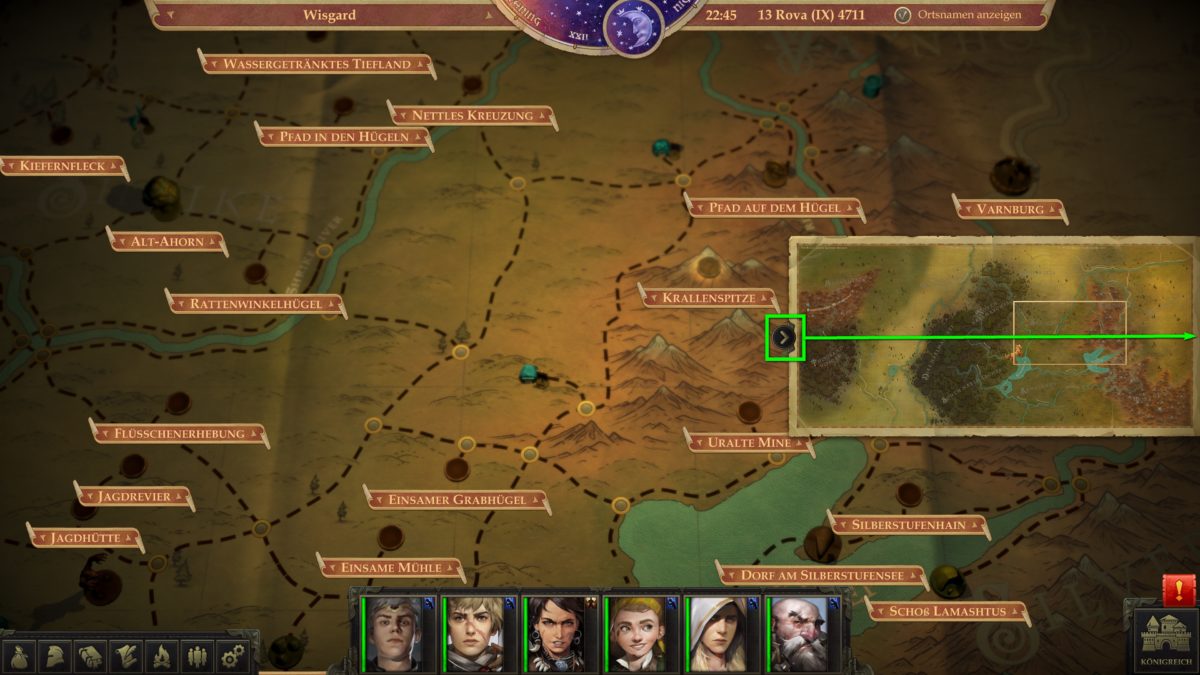
Travelling on the world map
You can either click on the small direction arrow at the bottom of the figure representing your group and travel to the next intersection. You can also click directly on your destination. A dialog box will appear, showing you the travel time. If you confirm, the figure will automatically move towards your destination. You can pause the journey at any time with the “Stop” button (in the middle of the lower third of the screen during a journey) and, for example, take a rest.
By the way, there’s no such thing as quick travel!
Saving, group management, resting & more
You can save at any time on the world map, for example by creating a quicksave. You can also use the menu item “Manage Group” to kick members out of the group and add new ones. As mentioned earlier in this article, this will cost you several days.
- Pro tip: If you have to enter a place alone (e.g. in the quest “A Just Reward”), you don’t have to travel all the way to your destination alone. You can take your entire party with you and send your fellow companions home again when you reach your destination (still on the world map, not in the level).
During extended journeys the characters get tired at some point. Then you have to rest. You can do that via the Rest menu. You can rest anywhere, there are neither better nor worse places to rest. You will find more information about this topic later in this article.
By the way, you can also manage your inventory or level ups while on the world map.
Use level maps effectively
The map that is available to you in a level (default key “M”) is a real-time map and interactive. Not only does it show you important positions, you can also navigate your party on this map. When you have completely explored a level and need to return to the exit, open the map and right-click near the exit. You can then watch your party go there on its own.
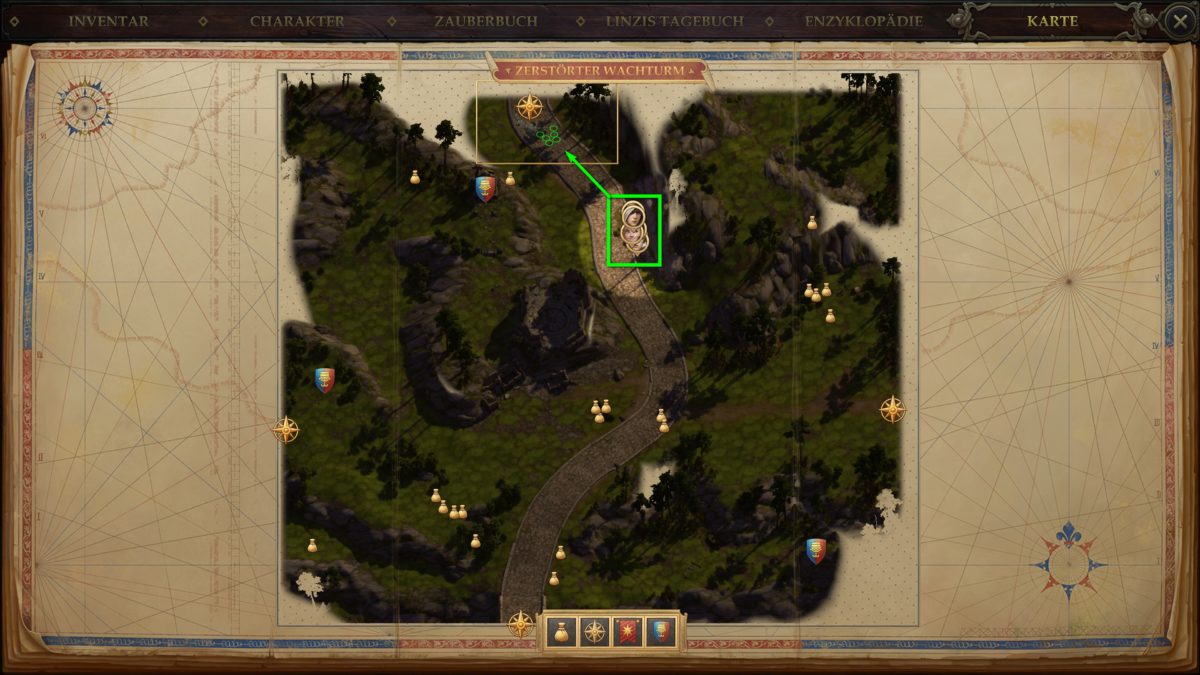
Tips and help for combat in Pathfinder: Kingmaker
In this section
- Save regularly
- Buffing before big fights
- Switch AI if necessary
- Pick the right targets and open a battle correctly
- Initiative, flat footed & attacks of opportunity
- Use skills wisely and efficiently
- Friendly Fire
- Proper healing
- Automated attack, additional abilities bar, items in belt & inventory
- Ability Damage & Death
- What should I do after a defeat?
In this guide section you will learn about
- Why and how you should save regularly
- How to prepare for battles properly
- What targets you should prioritize
- How you heal properly & what happens at death
- How you should deal with defeats
Fights are a major part of Pathfinder: Kingmaker. This is where the decision is made on how well we put our group together, whether we equipped and trained them reasonably and what we are capable of in terms of tactics.
Especially at the beginning it’s not easy for beginners to keep track on everything. We can also run into extremely strong or even overwhelming opponents early in the game. So what to do?
Save regularly
As mentioned before, it is very important to save regularly in this game. This applies especially to the first time you enter a level, but also directly after each fight or dialogue. This way we always have a very up-to-date savegame that we can load in case of failure.
Buffing before big fights
If you have configured the automatic pause correctly, you will usually have enough time to position and buff your group appropriately. First, use long lasting buffs such as Fox’s Cunning or Bull’s Strength. Before you attack the enemy cast short-term blessings. Also make sure that the bard in your group has activated his supporting performance.
Switch AI if necessary
If you don’t want your characters to act according to their AI script and attack enemies directly, turn off the AI to the right of the abilities bar. For example, this allows you to “kite” slow but dangerous enemies (i.e., lure them after you) as you attack them in ranged combat without having to call back ferocious melee fighters all the time.
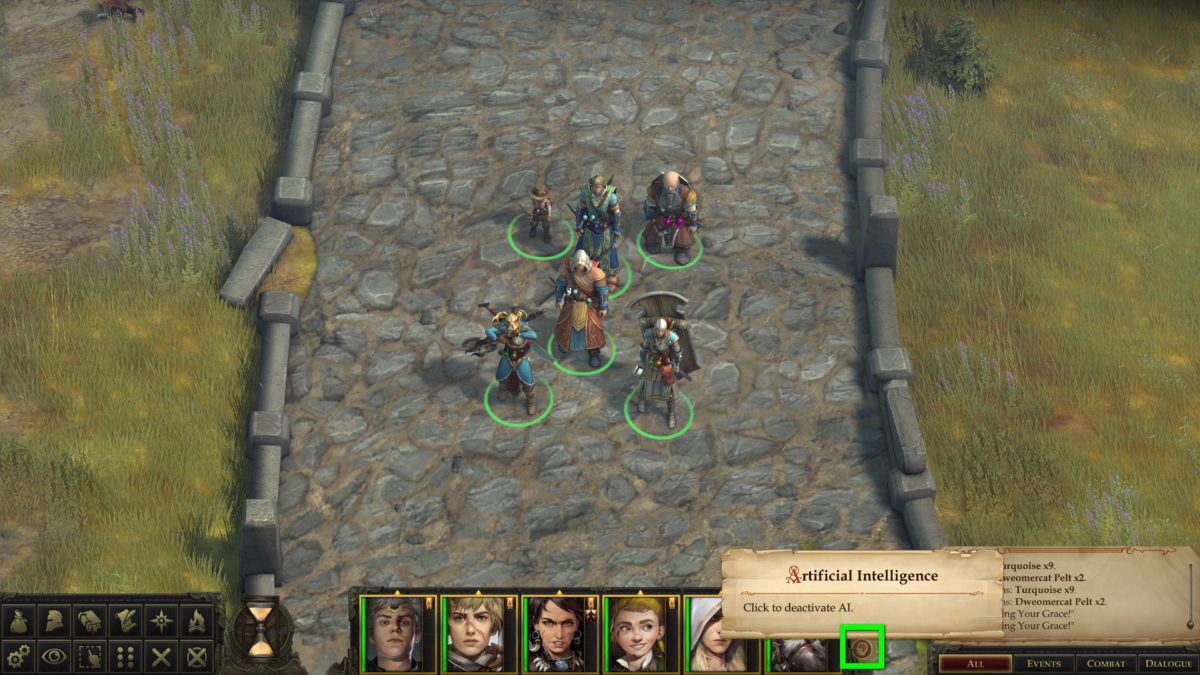
But don’t forget to turn it on again at the right moment – otherwise you might find that one or the other character just stands around.
Pick the right targets and open a battle correctly
If you have configured the automatic pause correctly, the game will pause as soon as enemies are spotted. At this point, you are usually not yet in combat and can prepare as described. Once your preparations are complete, you will need to consider how to engage in combat.
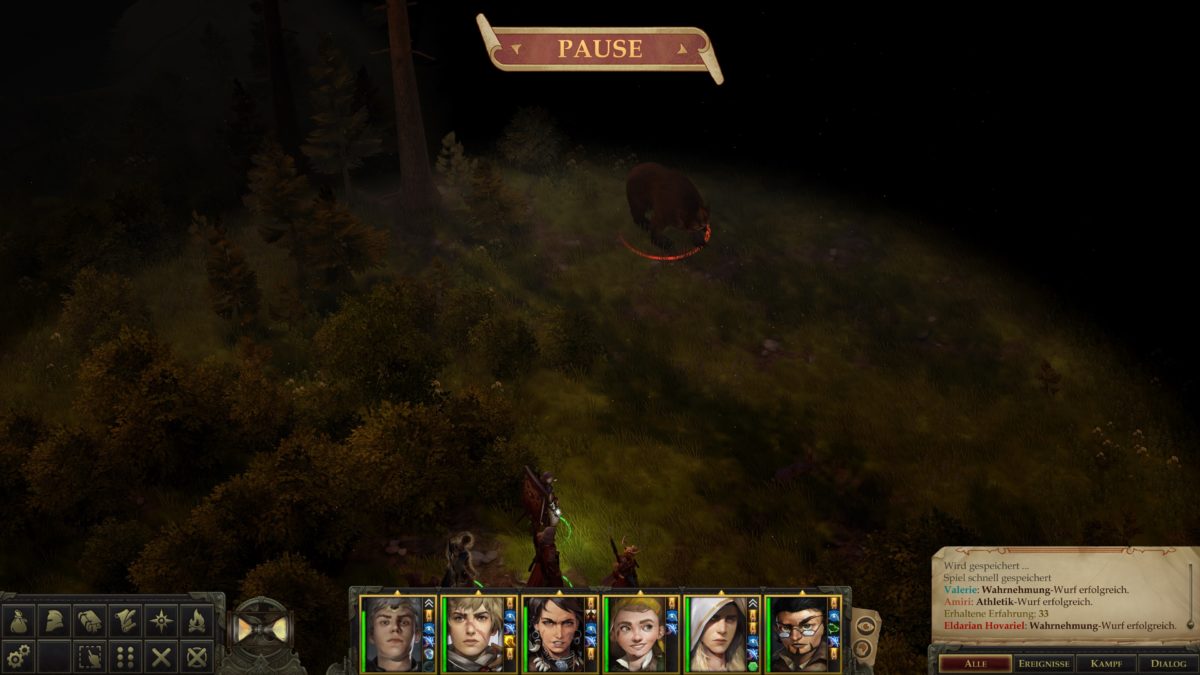
As a general rule, your melee fighter with the highest armor class will fight the most dangerous enemy or pull several enemies on him. You can do this either by using the Charge ability or by letting the tank run near those enemies. Sometimes you can pull enemies out of a group and fight them separately (e.g. with a well-aimed arrow or spell). The opponent’s target will then be displayed with a red line (visible via mouseover on the respective character). Depending on how dangerous the enemy or enemies are and how fast or hard they attack, a cleric should be ready to heal. Make sure that the cleric is not too far away, because healing requires him to be in touch with the injured person – and if he has to run half a marathon first, it can easily be too late.
You can also open a fight with a devastating spell. For example, a good wizard can kill an enemy directly with the spell Phantasmal Killer. Or he can cast an area spell to open battle (e.g. Fireball) and hit several enemies at once. It’ s important that the wizard retreats behind the melee fighters in time.
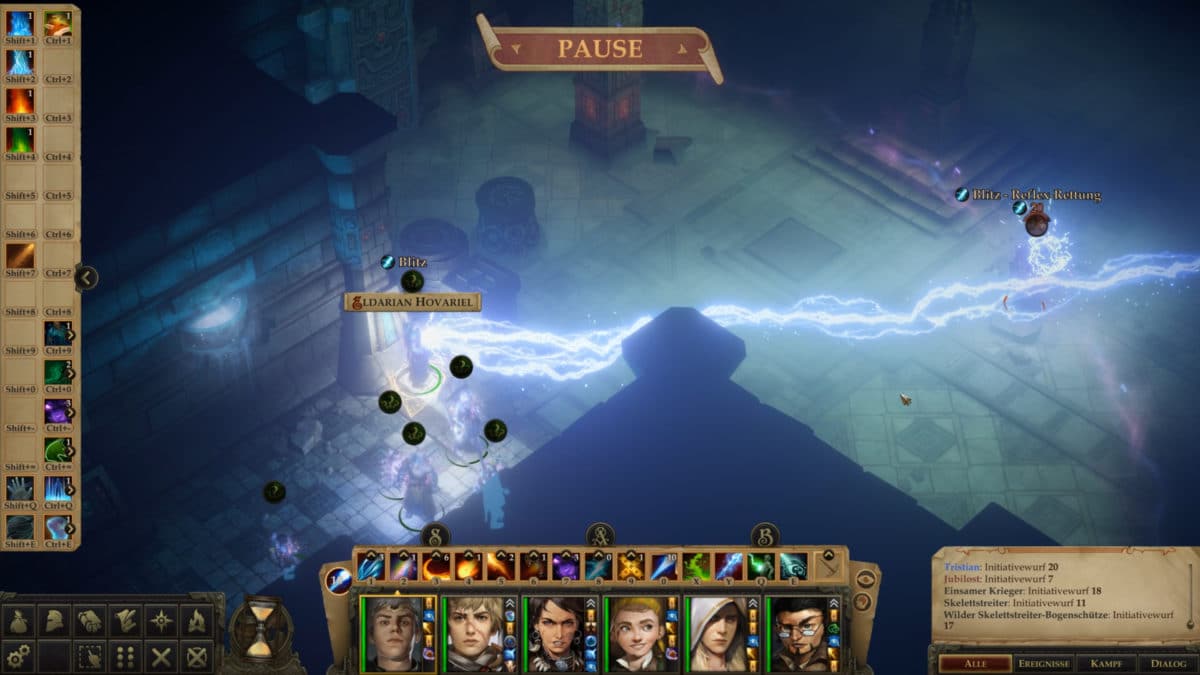
In any case, you should prioritize your goals. As a rule of thumb: Healers first, then wizards and alchemists, followed by ranged fighters and melee fighters. While your tank pulls melee fighters, the rest of your party can focus on the healer or wizard. Always assign targets to your companions manually, especially in tougher battles. Otherwise, it can quickly happen that your warriors will collectively take care of less important targets just because they are nearby.
- Pro Tip 1: If you’re fighting enemies who can use Necromancy or summon monsters, it may be a good idea to focus exclusively on the summoner. In most cases, his summons will die with him.
- Pro Tip 2: If you fight really hard opponents or very large groups, try to fight in a bottleneck. Put the fighter with the highest armor class in the bottleneck (e.g. a door). Only a few opponents can take part in this fight. Attack the enemies in the queue with your ranged fighters and decimate them one by one.
Initiative, flat footed & attacks of opportunity
If a fight starts with an attack, the initiative is rolled first and once. This is a dexterity throw that determines which participant of the conflict can act in which order. The higher the initiative roll, the earlier a character can act.
If a character has not yet been able to act because of his initiative throw, but is attacked, he is considered “flat footed”. In this case, his dexterity modifier is not counted to his armor class. In addition, he cannot perform attacks of opportunity.
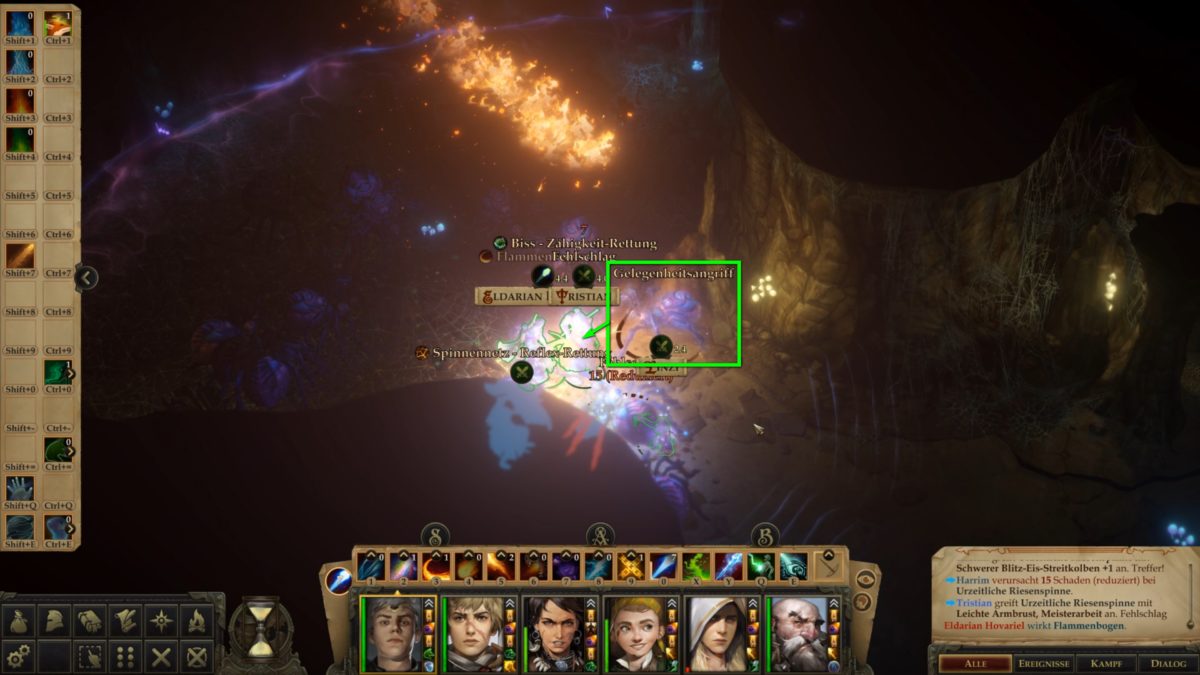
Attacks of opportunity are additional attacks that a character can perform when the opponent is casting spells, attacking from range or moving away from the opponent. Normally, each character can only attack as often as his or her stats allow within a turn (a round lasts six seconds), usually exactly once.
Under the influence of blessings (e.g. haste) multiple attacks are possible. Attacks of opportunity are even added on top of this. Therefore, be careful not to move a character away from an enemy unless there is an important reason for doing so or the character has enough hit points left to survive the damage resulting from the inevitable attack of opportunity.
Use skills wisely and efficiently
Don’t fire the biggest guns in every little fight. If you waste your most powerful spells on a few wolves or goblins, you’ll soon find yourself fighting really hard monsters with your pants down.
Which and how many abilities you should use against which opponent type will ultimately depend on your experience. After a period of getting used to the game, you’ll be beating up wolves, including alpha wolves or a pack of troll hounds with automatic attacks.
Friendly Fire
Yes, you can kill your group members yourself. Just let your wizard throw a fireball and see what happens. Do you notice anything? Exactly: It’s not a very good idea to use area spells in a way that affects your own team.
Instead, you should align the area of effect so that it hits as many enemies and as few friends as possible. One exception to this are special spells such as Controlled Fireball, which deals minimal damage to allies.
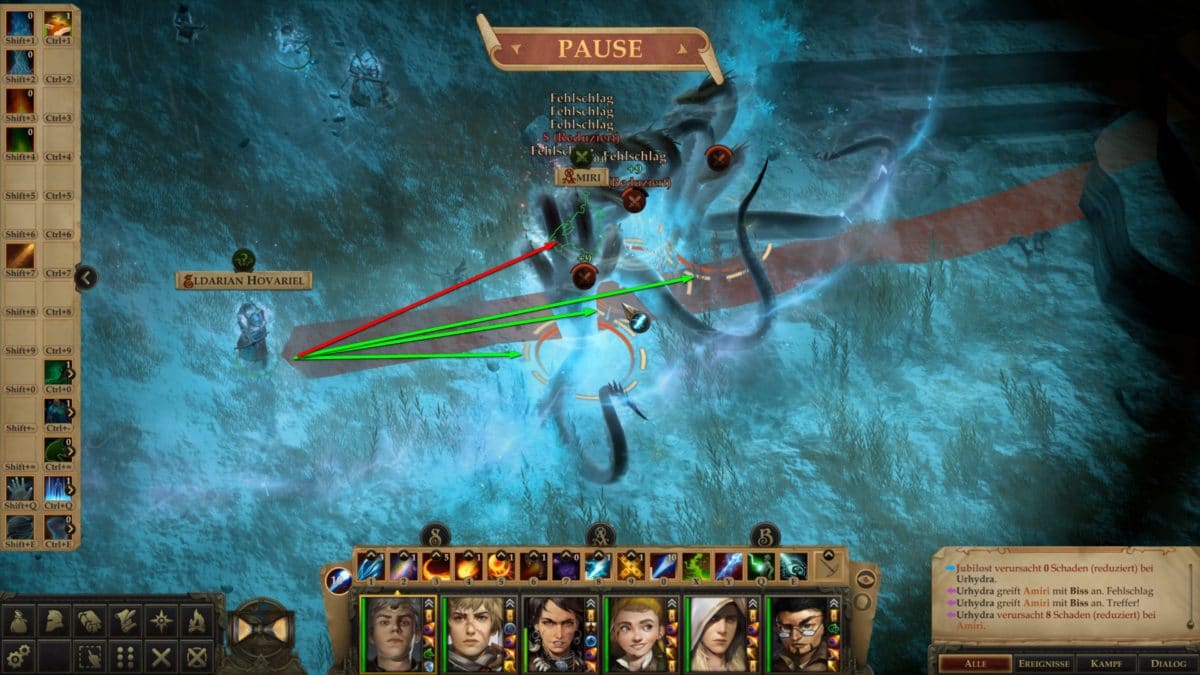
- Pro tip: If you have selected an area spell and want to place it, hold the CTRL key to place the spell perfectly. The creatures and characters you hit will be highlighted. This will help you avoid friendly fire.
Proper healing
Clerics, bards, druids, inquisitors and paladins can heal. However, the execution of a healing spell takes some time. This means you need to cast healings well in advance, rather than waiting until a party member’s hit points are close to zero.
As we learned in the section on opening up combat above, a healer should always be at a medium distance from the front line, as he needs to be close enough to target to execute a healing spell. Long distances in tight battles can lead to defeat. At the same time, he must not be within range of area spells or area attacks. Once you have completed a healing, the healer should immediately retreat from the frontline.
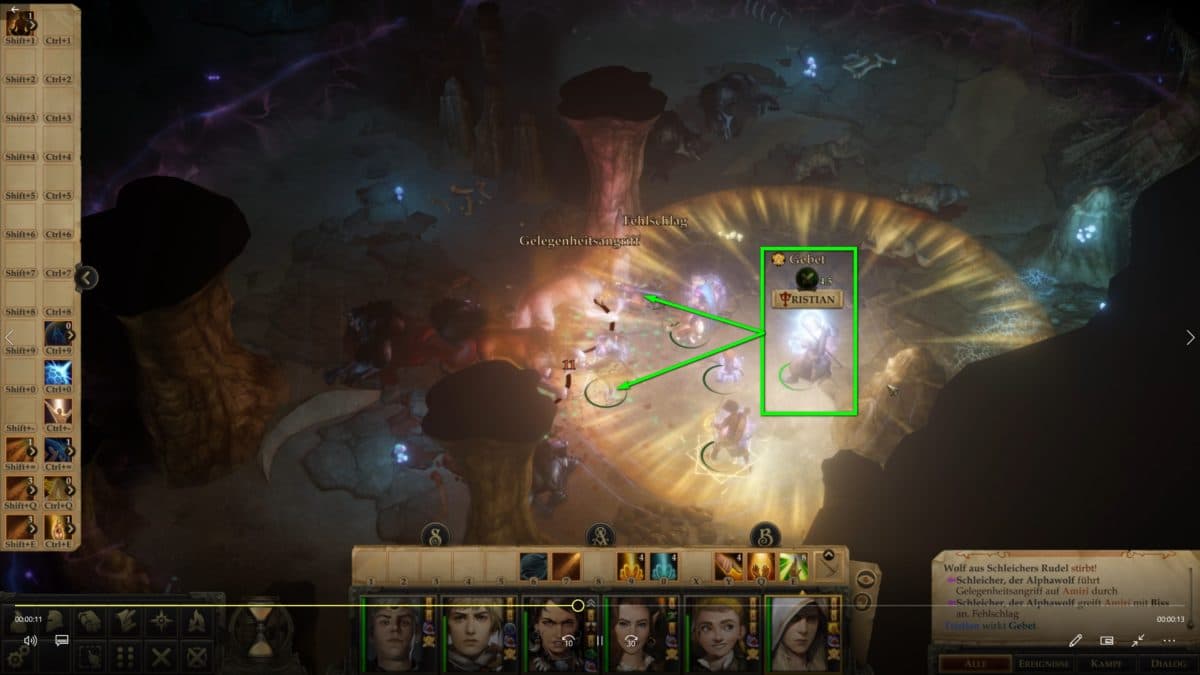
Very helpful are the mass healings of the cleric, especially “Channel Positive Energy – Heal Living”. Thus, area damage can be negated for all group members within the radius of effect. This spell can also be cast several times in a row, e.g. to absorb incoming damage to multiple melee fighters at the same time.
- Attention: Such area healings bring fallen companions back to life, but with only a few hit points. If the companion is lying right in the middle of the moshpit, it can quickly happen that he is knocked down again due to attacks of opportunity by enemies and definitely dies. Thus, in cases where a fallen companion lies in an unfavorable position, you should avoid healing with area spells. Instead, use targeted healing spells and retrieve fallen group members in the right moment.
Automated attack, additional abilities bar, items in belt & inventory
To the left of the abilities bar there is a small icon (shown in the picture). This is the automated attack of a character. By right-clicking on any ability in your abilities bar, you can configure the type of auto-attack used.
For example, you can have a wizard shoot his magic projectiles via auto-attack, so you don’t have to manually select the spell all the time. However, be aware that spells and abilities are not unlimited. Change the type of attack you use if necessary.
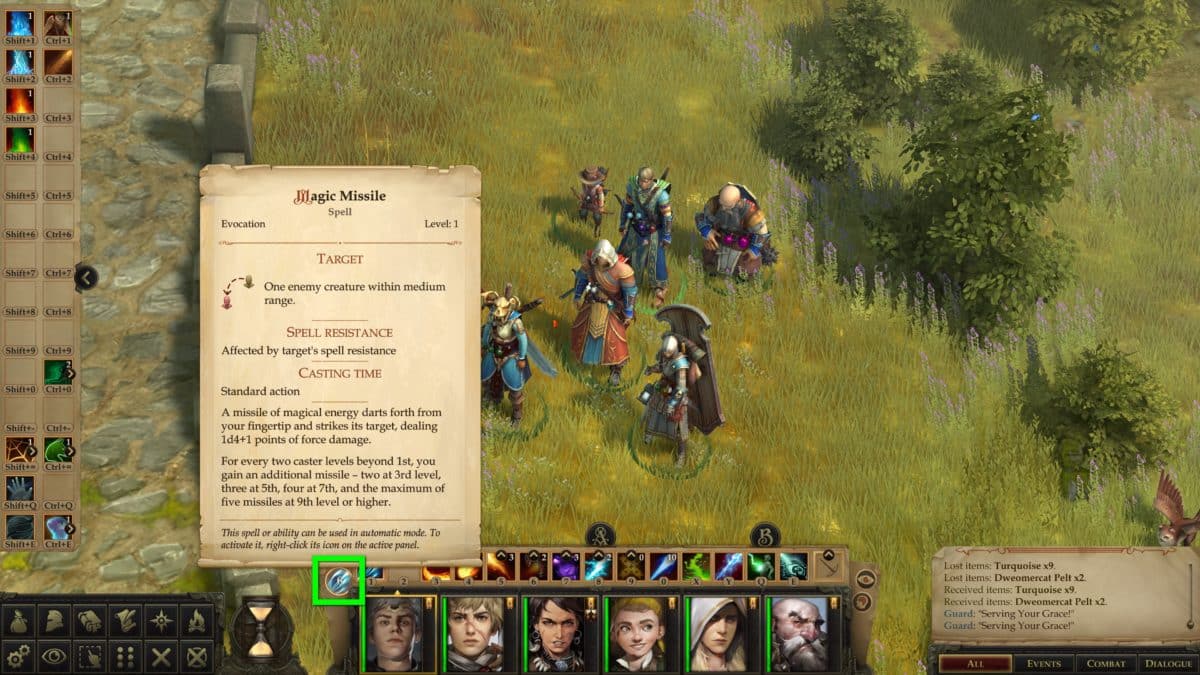
Over time, you’ll get more spells and abilities than you can fit into the abilities bar. Fortunately, there are two more skill bars on the left side of the screen. Press the small arrow button twice to activate two more skill bars.
Don’t forget your belt and inventory either. You can place potions, wands and scrolls in the belt (the right round button above the abilities bar) to use in battle. The belt can also be filled with inventory items during combat. Depending on how well each character can use magical items (see the Skills section earlier in this guide), wands and scrolls can be extremely helpful and can make a difference in battles.
Ability Damage & Death
There are a number of enemies that will inflict permanent ability damage on you. For example, spiders can inflict constitution damage, which has a direct negative impact on the character’s health pool. Other monsters cause strength damage, resulting in significantly reduced attack power. Also, poison can continuously inflict ability damage if the poison is not neutralized (for example, with the cleric’s Neutralize Poison spell).
Such damage is shown as an icon in the character portrait. It can be cured by the cleric spells “Restoration, Lesser” or “Restoration” (the latter requires with diamond dust an expensive reagent). However, we recommend collecting or buying “Potions of Restoration, Lesser” for such situations. If you are near a safe location ( e.g. the Throne Room or Oleg’s Trading Post), you can simply rest until the attribute damage is healed. One point of attribute damage is usually healed per rest.

Depending on the level of difficulty you are playing or the settings you have made, the death of a character may look different. In Story Mode, a character simply becomes unconscious in the event of death and gets up again after a fight. In simple difficulty mode, a character also becomes unconscious and gets up again after a fight. However, if his hit points drop to a negative value, which corresponds to his constitution value, he dies. In this case, a resurrection spell must be cast.
At the normal difficulty level, a character does not die immediately when fatally injured, but becomes unconscious. If he is healed or if he gets up automatically after the fight, he gets the “Death’s Door” condition permanently. This means that the next time he suffers a fatal injury in this state, he dies permanently and can only be brought back by a resurrection spell. Death’s Door can only be removed by resting in a safe location (e.g. the Throne Room or Oleg’s Trading Post).
What should I do after a defeat?
- Simply load the last saved game and return later.
You’ll suffer multiple defeats during the course of the game and encounter enemies who are wiping the floor with you at this point. If you’ve taken our advice and saved regularly, there’s no problem: just load the last savegame and come back later.
That’ s no shame at all, it’s part of the game. For example, the open world makes it possible for you to run early into the claws of a Linnorm even though you can’t beat it yet. Just return later when you’re bigger, stronger and better equipped.
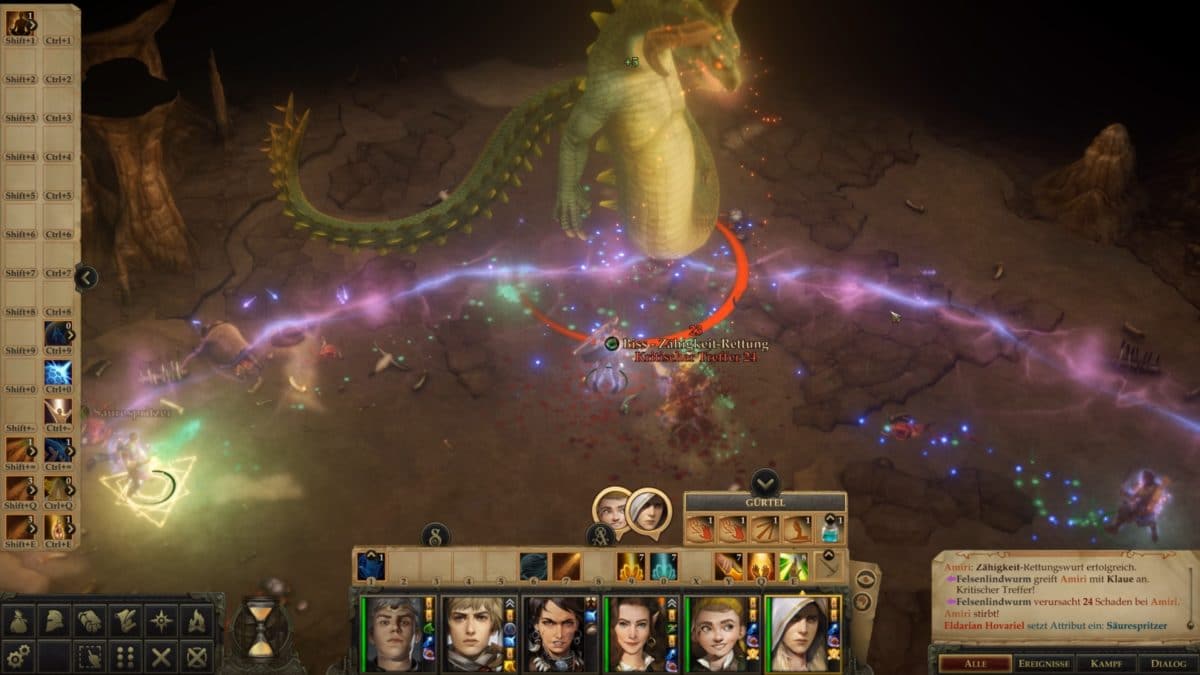
However, if you’ve just lost a fight or you’re at a point in the story where you are forced to fight, reload as well – but change your strategy. Now you know what the enemy is doing, who is most dangerous and what events to avoid. Adjust to this and also adapt the use of your abilities and spells to it (for example, by casting “Resist Energy” on the group).
For example, if you’re facing an Owl Bear causing real trouble, try to slow the already sluggish creature down even further with appropriate spells (such as Web) and keep your party members at a distance. In ranged combat and with the appropriate spells you will get rid of this beast.
Guide to recovering, resting & camping
In this guide section you will learn about
- Why you have to rest regularly
- How to manage your camp effectively
- Which special roles of your party members are useful and which are not
- What recipes exist and what they do
Your group members get tired over time. How quickly they get tired depends among other things on the individual burden. In your inventory you can see directly below each character’s equipment the weight they have to carry. The higher it is, the faster the character gets exhausted.
When characters are tired, they receive a penalty of -2 for strength and dexterity. Their fatigue will also be indicated by an icon next to the character’s portrait or by yawning or by a comment. Then you should rest. If you click on the menu item on the world map, the camp menu will open up. If you are inside a level, you have to set the camp manually first. If it changes from red to green, you can set it up at that location. A double-click on the camp will let your group rest.
When you are resting in a level, there are always conversations between your companions and every now and then conversations with your main character as well. This is especially important if you’re looking for romances. Therefore, rest from time to time not just on the world map, but inside the levels.
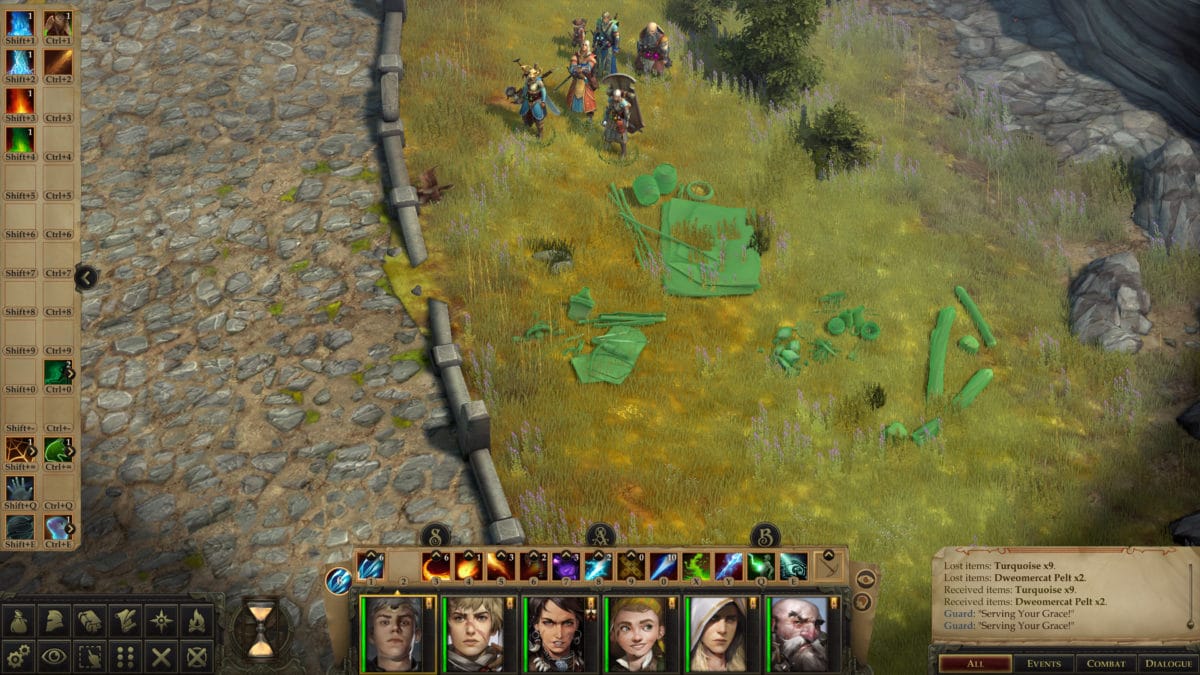
At the top of the camp menu you will find the timeline. There you can adjust the length of the rest by moving the golden indicator. Then click on “Manage” and you’ll be taken to a menu where you may assign tasks.
Assign the appropriate tasks to companions
Drag and drop the portraits of your group into the respective task areas, for example hunting, cooking or night watch. The bonus that a character provides for each task will be displayed below the required skill. Assign the most skilled characters to the respective task.
Camp safety is a priority
Don’t rest in areas you haven’t explored yet. In general, we recommend to rest on the world map whenever possible. In our experience, there are considerably fewer attacks that occur on the camp.
Also make sure that the character with the highest value for stealth takes care of camp camouflage. In addition, it is worth assigning characters to special roles that improve camp security.
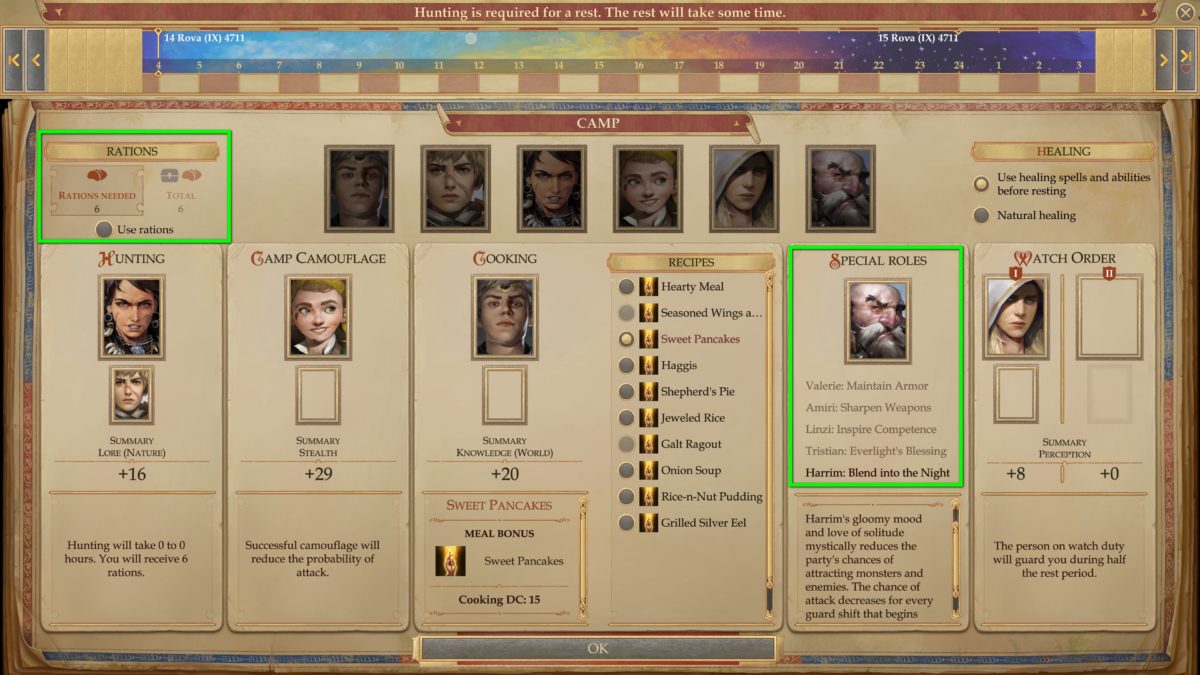
If the group is raided while sleeping, it has no time to prepare or put on heavy armor. Characters can’t sleep in their armor, so they’ll have to do without protection when ambushed.
Special Roles
The following characters can perform the following special resting tasks.
| Character | Special Role | Effect | Remarks |
|---|---|---|---|
| Amiri | Sharpen Weapons | Amiri’s damage in the first battle within the next 12 hours is increased by +1. This effect is increased by +1 every four levels after reaching the third level. | Can be useful before a hard fight. |
| Regongar | Intimidating Posture | Most enemies weaker than Regongar do not attack the camp. | Not very helpful, because the group can handle weaker enemies. |
| Ekundayo | Wilderness Survival | Decreasing ration consumption by 2. | Worthwhile in caves or dungeons where hunting is not possible. |
| Harrim | Blend into the Night | Reduces the chance of attracting enemies. The probability decreases with each guard shift during the night. | Very helpful in terms of camp safety. |
| Jaethal | Undead Guardians | Two undead warriors guard the camp and support the group in the event of an attack. | The special roles of Harrim, Nok-Nok and Octavia are preferable in terms of camp safety. |
| Jubilost | Effective Management | Camping time is reduced by 1 hour. | It’s not worth it. |
| Linzi | Inspire Competence | Gives a competence bonus of +2 for camp duty skills. This effect increases by +1 every four levels after reaching the third level. | If you specialize Linzi on stealth, she’s better at camp camouflage. |
| Nok-Nok | Set Traps | Set traps around the camp to protect against monsters and snap in the event of an attack. | Quite helpful in terms of camp safety. |
| Octavia | Set Alarm | Octavia casts an alarm spell that lasts for one guard shift and warns of all enemies in the area. | Ensures that the group won’t be attacked while sleeping. |
| Tristian | Everlight’s Blessing | Doubles hit point recovery and regeneration from ability damage | Very handy when the group has suffered severe ability damage |
| Valerie | Maintain Armor | Valerie gets a +1 armor bonus in the first battle within 12 hours. This effect increases by +1 every 4 levels after reaching the third level. | Can be useful before a hard fight. |
Hunting, cooking, recipes and their effects
For successful camping, the party needs rations. Outside of caves or dungeons, the group can hunt and cook. You can set the rations (which can be bought from merchants) to be used in the top left corner of the Resting menu. This will save you time, as a successful hunt takes some time.
However, rations weigh a lot and can put a significant burden on the group. As indicated above, you will definitely need rations if you enter complex cave systems or dungeons. Hunting and cooking are not possible there.
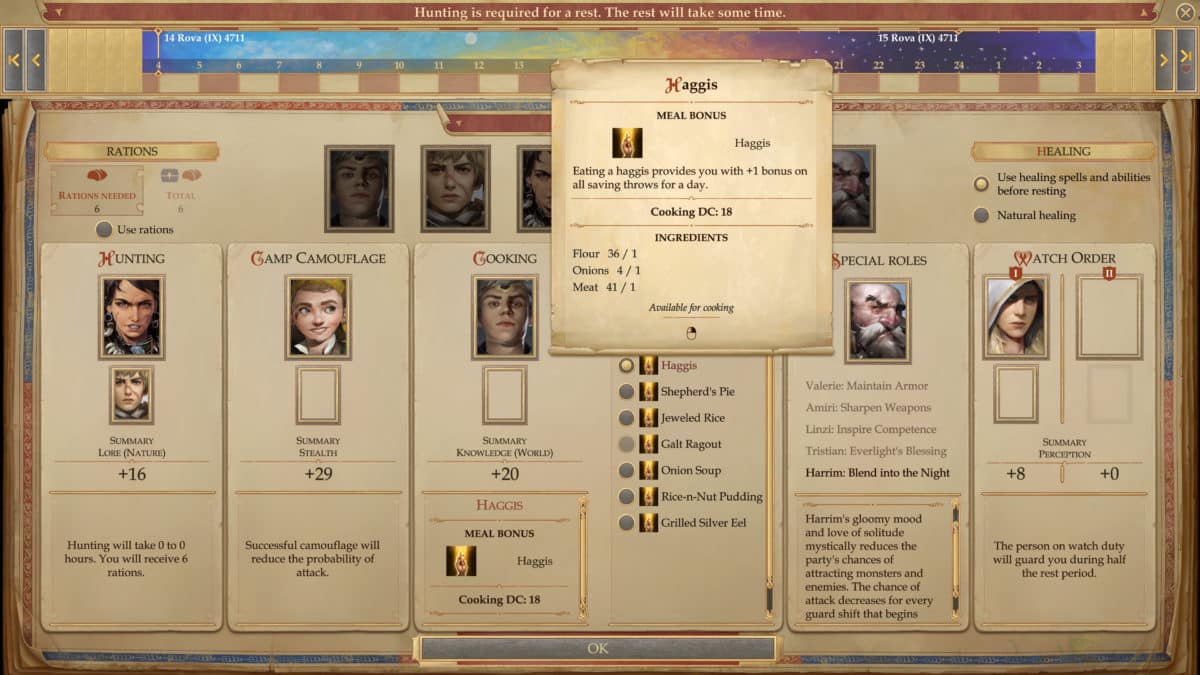
On your travels you’ve probably already found some recipes and by right-clicking the recipe in your inventory it will be added to your recipe book. These recipes are listed in the administration menu of your camp and you can see if you have the right ingredients at hand. If so, your chef will be able to try the recipe. The meal will provide the group with various temporary bonuses. If the meal is also one of your party members’ favorites, they will receive an additional temporary bonus.
Below we have compiled all the recipes we know for you. Please note that the bonuses for a character’s favorite food will be added to the normal bonus of the meal.
List of Recipes
| Recipe | Ingredients | DC | Favorite Meal | Bonus | Location |
|---|---|---|---|---|---|
| Baked Spider Legs | Flour Vegetables Giant Spider Legs | 23 | Nok-Nok | +3 to Fortitude saves Nok-Nok: +5 to Stealth checks | Spider Lair |
| Black Linnorm Stew | Eggs Mushrooms Wyvern Meat Linnorm Tenderloin | 34 | +2 to maximum HP per character level and fast healing | Abandoned Keep | |
| Broiled Tuskwater Oysters | Butter Soft Cheese Tuskwater Oysters | 24 | +1 to all spell DCs | Blood Furrows | |
| Cheese Crostata | Flour Cheese Shambletus | 24 | Harrim | +6 hours before fatigue Harrim: +5 Lore (Religion) checks | Overgrown Cavern |
| Chocolate Ice Cream | Butter Milk Chocolate | 20 | Linzi | +3 to all skill checks Linzi: +5 to Knowledge (World) | |
| First World Mince Pie | Flour Nuts Chocolate First World Fruit | 35 | Linzi | +4 to random ability score for a day Linzi: +5 to all skill checks | Serpent Trail |
| Fish-on-a-Stick | Butter Trout Edible Moss | 15 | Nok-Nok | +4 hours before fatigue Nok-Nok: +3 Trickery, +3 Use Magic Device | Swamp Witch’s Hut |
| Galt-Ragout | Butter Mushroom Fowl | 16 | Valerie | +4 hours before fatigue Valerie: Half penalty for fighting defensively | A Ford Across the Skunk River |
| Giant Scrambled Egg With Shambletus | Milk Herbs Shambletus Roc Egg | 33 | +3 to attack, damage, skill checks and saving throws | Armag’s Tomb | |
| Grilled Silver Eel | Butter Herbs Silver Eel | 22 | Jubilost | +10 move speed Jubilost: +5 Trickery | Lake Silverstep Village |
| Haggis | Flour Onions Meat | 18 | Harrim | +1 to Will saves Harrim: +3 to Will saves | Pine Patch |
| Hearty Meal | Keine | +1 to saving throws | |||
| Hearty Purple Soup | Milk Fowl Mastodon Meat Purple Worm Cut | 35 | Immunity to poisons and diseases Removes all poison and disease effects and fully restores hit points | Fossil Fields | |
| Hunter’s Roast | Flour Tenderloin Potatoes | 16 | Ekundayo | +1 temporary hit point Ekundayo: +3 to Lore (Nature) | Hunting Grounds |
| Jeweled Rice | Rice Nuts Fruit | 15 | Jaethal | +5 move speed Jaethal: +5 move speed | Old Sycamore Depths |
| Kameberry Pie | Flour Fruits Kameberry | 21 | Tristian | Fast healing Tristian: +5 Lore (Religion) | Lone House City of Hollow Eyes |
| Mastodon-Steak | Butter Herbs Mastodon Meat | 21 | Regongar | 1.5 HP per character level Regongar: +5 Concentration | Linnorm’s Grave |
| Monster Casserole | Eggs Cheese Wyvern Meat | 22 | Amiri | +2 bonus on damage rolls Amiri: +5 to Athletics | Talon Peak |
| Onion Soup | Flour Onions Cheese | 17 | Jubilost | +1 to saving throws Jubilost: +3 to skill checks | Ruined Watchtower |
| Owlbear Omelette | Milk Tenderloin Owlbear Egg | 22 | Ekundayo | +1 bonus on attack rolls Ekundayo: +5 bonus to Lore (Nature) | Varnhold |
| Rice-n-Nut-Pudding | Rice Milk Nuts | 15 | Octavia | +5 move speed Octavia: +1d6 sneak attack damage with spells | Three-Pine Island |
| Seasoned Wings and Thighs | Butter Fowl Edible Moss | 14 | Amiri | 1 temporary hit point per level Amiri: +2 to confirm critical hits | Troll Lair Oleg‘s Trading Post (Oleg) |
| Sheperd’s Pie | Flour Potatoes Meat | 17 | Tristian | +1 to saving throws Tristian: +1d6 Channel Positive Energy | Alt-Ahorn-Höhlen oder Hütte der Sumpfhexe |
| Smoked Trout and Hydra Pate | Eggs Trout Hydra Eye | 24 | Valerie | +1 bonus AC Valerie: +5 to Athletics checks for 24 hours | |
| Succulent Sausages | Butter Edible Moss Meat | 17 | Regongar | +1 temporary hit point per level Regongar: +2 to concentration and caster level checks | Monster Den |
| Sweet Pancakes | Eggs Flour Honey | 15 | Linzi | +5 move speed Linzi: +5 move speed | Dornenfurt |
| Whiterose Oysters | Rice Soft Cheese Tuskwater Oysters “White Rose” Chardonnay | 33 | +4 to concentration checks and caster level checks, increasing spell DCs by +2 | Two-Faced Hill |
Kingdom & Advisors: What you should know
The management of your own barony is a complex undertaking that requires a lot of attention. The barony is directly interwoven with the story and your skill as a regent can decide whether the whole adventure is successful or not.
To make sure you don’t do anything wrong and become a good baron, we have written a comprehensive guide to Kingdom and Advisors in Pathfinder: Kingmaker.
Quest solutions, puzzles & boss fights in Pathfinder: Kingmaker
You don’t know what to do on a quest? A puzzle or a boss fight is just too hard for you? You’ll find helpful tips in our quest and boss fighting guide in Pathfinder: Kingmaker.
General game tips
- If you need to take a short break (e.g. to go to the fridge), always press space bar to activate the pause (unless you’re on the world map, where play time doesn’t proceed). Some quests have a time limit and if you just let the time pass by, that might eventually take its toll later on.
No related articles found.

